Hawaii
Hawaii (/həˈwaɪ.i/ (![]() listen) hə-WY-ee; Hawaiian: Hawaiʻi [həˈvɐjʔi] or [həˈwɐjʔi]) is a U.S. state located in the Pacific Ocean. It is the only state outside North America, the only island state, and the only state in the tropics. Hawaii is also one of a handful of U.S. states to have once been an independent nation.[11][12]
listen) hə-WY-ee; Hawaiian: Hawaiʻi [həˈvɐjʔi] or [həˈwɐjʔi]) is a U.S. state located in the Pacific Ocean. It is the only state outside North America, the only island state, and the only state in the tropics. Hawaii is also one of a handful of U.S. states to have once been an independent nation.[11][12]
Hawaii
Hawaiʻi (Hawaiian) | |
|---|---|
| State of Hawaii Mokuʻāina o Hawaiʻi (Hawaiian) | |
| Nickname(s): | |
| Motto(s): | |
| Anthem: Hawaiʻi Ponoʻī (Hawaiʻi's Own True Sons)[4] | |
_(US50)_(-grid).svg.png.webp) Map of the United States with Hawaii highlighted | |
| Country | United States |
| Before statehood | Territory of Hawaii |
| Admitted to the Union | August 21, 1959 (50th) |
| Capital (and largest city) | Honolulu |
| Largest metro | Island of Oʻahu |
| Government | |
| • Governor | David Ige (D) |
| • Lieutenant Governor | Josh Green (D) |
| Legislature | State Legislature |
| • Upper house | Senate |
| • Lower house | House of Representatives |
| Judiciary | Supreme Court of Hawaii |
| U.S. senators |
|
| U.S. House delegation | 1: Ed Case (D) 2: Kai Kahele (D) (list) |
| Area | |
| • Total | 10,931 sq mi (28,311 km2) |
| • Land | 6,423 sq mi (16,638 km2) |
| • Water | 4,507 sq mi (11,672 km2) 41.2% |
| Area rank | 43rd |
| Dimensions | |
| • Length | 1,522 mi (2,450 km) |
| • Width | n/a mi (n/a km) |
| Elevation | 3,030 ft (920 m) |
| Highest elevation | 13,796 ft (4,205.0 m) |
| Lowest elevation | 0 ft (0 m) |
| Population (2019) | |
| • Total | 1,415,872 |
| • Rank | 40th |
| • Density | 221/sq mi (82.6/km2) |
| • Density rank | 13th |
| • Median household income | $77,765[9] |
| • Income rank | 4th |
| Demonym(s) | Hawaii resident,[10] Hawaiian[lower-alpha 1] |
| Language | |
| • Official languages | English, Hawaiian |
| Time zone | UTC−10:00 (Hawaii) |
| USPS abbreviation | HI |
| ISO 3166 code | US-HI |
| Traditional abbreviation | H.I. |
| Latitude | 18° 55′ N to 28° 27′ N |
| Longitude | 154° 48′ W to 178° 22′ W |
| Website | portal |
| Hawaii state symbols | |
|---|---|
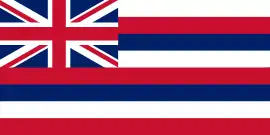 | |
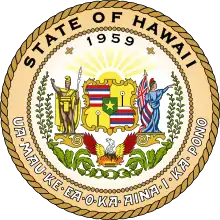 | |
| Living insignia | |
| Bird | Nene |
| Fish | Humuhumunukunukuāpuaʻa |
| Flower | Pua aloalo |
| Insect | Pulelehua |
| Tree | Kukui tree |
| Inanimate insignia | |
| Dance | Hula |
| Food | Kalo (taro) |
| Gemstone | ʻĒkaha kū moana (black coral) |
| Other | Heʻe nalu (surfing) (state individual sport) |
| State route marker | |
 | |
| State quarter | |
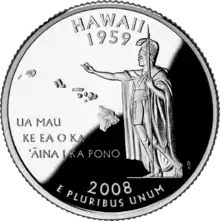 Released in 2008 | |
| Lists of United States state symbols | |
Hawaii encompasses nearly the entire Hawaiian archipelago, composed of 137 volcanic islands spanning 1,500 miles (2,400 km), which are physiographically and ethnologically part of the Polynesian subregion of Oceania.[13] The state's ocean coastline is consequently the fourth longest in the U.S., at about 750 miles (1,210 km).[lower-alpha 2] The eight main islands, from northwest to southeast, are Niʻihau, Kauaʻi, Oʻahu, Molokaʻi, Lānaʻi, Kahoʻolawe, Maui, and Hawaiʻi, after which the state is named; it is often called the "Big Island" or "Hawaii Island" to avoid confusion with the state or archipelago. The uninhabited Northwestern Hawaiian Islands make up most of the Papahānaumokuākea Marine National Monument, the largest protected area in the U.S. and the third largest in the world.
Settled by Polynesians some time between 124 and 1120, Hawaii was home to numerous independent chiefdoms. British explorer James Cook was the first known non-Polynesian to discover the archipelago in 1778; early British influence is reflected in the design of the state flag. An influx of explorers, traders, and whalers arrived shortly thereafter, introducing diseases that decimated the once-isolated indigenous community. Hawaii became a unified, internationally recognized kingdom in 1810, remaining independent until Western businessmen overthrew the monarchy in 1893; this led to annexation by the U.S. in 1898. As a strategically valuable U.S. territory, Hawaii was attacked by Japan on December 7, 1941, which brought it global and historical significance, and contributed to America's decisive entry into World War II. Hawaii became the most recent state to join the union on August 21, 1959.[14] In 1993, the U.S. government formally apologized for its role in the overthrow of Hawaii's government, which spurred the Hawaiian sovereignty movement.
Of the fifty U.S. states, Hawaii is the eighth-smallest in area and the 11th-least populous, but with 1.4 million residents is the 13th-most densely populated. Two-thirds of the population lives on the island of O'ahu, home to the state's capital and largest city, Honolulu. Hawaii is among the most diverse states in the country, owing to its central location in the Pacific and over two centuries of migration; it has the nation's only Asian American majority, largest Buddhist community,[15] and largest proportion of multiracial people.[16] Consequently, the state is a unique melting pot of Southeast Asian, East Asian and North American cultures, in addition to its indigenous Hawaiian culture.
Historically dominated by a plantation economy, Hawaii remains a major agricultural exporter due to its fertile soil and uniquely tropical climate in the U.S. Its economy has gradually diversified since the mid 20th century, with tourism and military defense becoming the two largest sectors. The state attracts tourists, surfers, and scientists from around the world with its diverse natural scenery, warm tropical climate, abundance of public beaches, oceanic surroundings, active volcanoes, and clear skies on the Big Island. Hawaii hosts the U.S. Pacific Fleet, the largest naval command in the world, as well as 75,000 employees of the Defense Department.[17]
Although its relative isolation results in one of the nation's highest costs of living, Hawaii ranks as the third wealthiest state in the U.S.;[17] Honolulu ranks high in several world livability rankings, ranking 22nd out of 140 cities worldwide in the 2019 Global Liveability Index, the highest of any American city.[18]
Etymology
The state of Hawaii derives its name from the name of its largest island, Hawaiʻi. A common Hawaiian explanation of the name of Hawaiʻi is that it was named for Hawaiʻiloa, a legendary figure from Hawaiian myth. He is said to have discovered the islands when they were first settled.[19][20]
The Hawaiian language word Hawaiʻi is very similar to Proto-Polynesian Sawaiki, with the reconstructed meaning "homeland".[lower-alpha 3] Cognates of Hawaiʻi are found in other Polynesian languages, including Māori (Hawaiki), Rarotongan (ʻAvaiki) and Samoan (Savaiʻi). According to linguists Pukui and Elbert,[22] "elsewhere in Polynesia, Hawaiʻi or a cognate is the name of the underworld or of the ancestral home, but in Hawaii, the name has no meaning".[23]
Spelling of state name
In 1978, Hawaiian was added to the Constitution of the State of Hawaii as an official state language alongside English.[24] The title of the state constitution is The Constitution of the State of Hawaii. Article XV, Section 1 of the Constitution uses The State of Hawaii.[25] Diacritics were not used because the document, drafted in 1949,[26] predates the use of the ʻokina ⟨ʻ⟩ and the kahakō in modern Hawaiian orthography. The exact spelling of the state's name in the Hawaiian language is Hawaiʻi.[lower-alpha 4] In the Hawaii Admission Act that granted Hawaiian statehood, the federal government recognized Hawaii as the official state name. Official government publications, department and office titles, and the Seal of Hawaii use the traditional spelling with no symbols for glottal stops or vowel length.[27]
Geography and environment
| Island | Nickname | Area | Population (as of 2010) |
Density | Highest point | Elevation | Age (Ma)[28] | Location |
|---|---|---|---|---|---|---|---|---|
| Hawaiʻi[29] | The Big Island | 4,028.0 sq mi (10,432.5 km2) | 185,079 | 45.948/sq mi (17.7407/km2) | Mauna Kea | 13,796 ft (4,205 m) | 0.4 | 19°34′N 155°30′W |
| Maui[30] | The Valley Isle | 727.2 sq mi (1,883.4 km2) | 144,444 | 198.630/sq mi (76.692/km2) | Haleakalā | 10,023 ft (3,055 m) | 1.3–0.8 | 20°48′N 156°20′W |
| Oʻahu[31] | The Gathering Place | 596.7 sq mi (1,545.4 km2) | 953,207 | 1,597.46/sq mi (616.78/km2) | Mount Kaʻala | 4,003 ft (1,220 m) | 3.7–2.6 | 21°28′N 157°59′W |
| Kauaʻi[32] | The Garden Isle | 552.3 sq mi (1,430.5 km2) | 66,921 | 121.168/sq mi (46.783/km2) | Kawaikini | 5,243 ft (1,598 m) | 5.1 | 22°05′N 159°30′W |
| Molokaʻi[33] | The Friendly Isle | 260.0 sq mi (673.4 km2) | 7,345 | 28.250/sq mi (10.9074/km2) | Kamakou | 4,961 ft (1,512 m) | 1.9–1.8 | 21°08′N 157°02′W |
| Lānaʻi[34] | The Pineapple Isle | 140.5 sq mi (363.9 km2) | 3,135 | 22.313/sq mi (8.615/km2) | Lānaʻihale | 3,366 ft (1,026 m) | 1.3 | 20°50′N 156°56′W |
| Niʻihau[35] | The Forbidden Isle | 69.5 sq mi (180.0 km2) | 170 | 2.45/sq mi (0.944/km2) | Mount Pānīʻau | 1,250 ft (381 m) | 4.9 | 21°54′N 160°10′W |
| Kahoʻolawe[36] | The Target Isle | 44.6 sq mi (115.5 km2) | 0 | 0/sq mi (0/km2) | Puʻu Moaulanui | 1,483 ft (452 m) | 1.0 | 20°33′N 156°36′W |
There are eight main Hawaiian islands. Seven of them are inhabited however only six of them are open to tourists and locals. The island of Niʻihau is privately managed by brothers Bruce and Keith Robinson; access is restricted to those who have permission from the island's owners.This island is also home to native Hawaiians. Access to uninhabited Kahoʻolawe island is also restricted and anyone who enters without permission will be arrested. This island may also be dangerous due to it was an military base during the world wars and could still have unexploded ordinances.
Topography
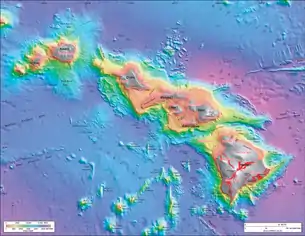
The Hawaiian archipelago is located 2,000 mi (3,200 km) southwest of the contiguous United States.[37] Hawaii is the southernmost U.S. state and the second westernmost after Alaska. Hawaii, like Alaska, does not border any other U.S. state. It is the only U.S. state that is not geographically located in North America, the only state completely surrounded by water and that is entirely an archipelago, and the only state in which coffee is commercially cultivable.
In addition to the eight main islands, the state has many smaller islands and islets. Kaʻula is a small island near Niʻihau. The Northwest Hawaiian Islands is a group of nine small, older islands to the northwest of Kauaʻi that extend from Nihoa to Kure Atoll; these are remnants of once much larger volcanic mountains. Across the archipelago are around 130 small rocks and islets, such as Molokini, which are either volcanic, marine sedimentary or erosional in origin.[38]
Hawaiʻi's tallest mountain Mauna Kea is 13,796 ft (4,205 m) above mean sea level;[39] it is taller than Mount Everest if measured from the base of the mountain, which lies on the floor of the Pacific Ocean and rises about 33,500 feet (10,200 m).[40]
Geology
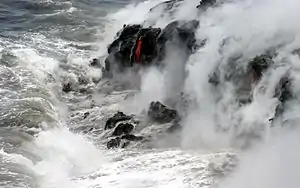
The Hawaiian islands were formed by volcanic activity initiated at an undersea magma source called the Hawaiʻi hotspot. The process is continuing to build islands; the tectonic plate beneath much of the Pacific Ocean continually moves northwest and the hot spot remains stationary, slowly creating new volcanoes. Because of the hotspot's location, all currently active land volcanoes are located on the southern half of Hawaiʻi Island. The newest volcano, Lōʻihi Seamount, is located south of the coast of Hawaiʻi Island.
The last volcanic eruption outside Hawaiʻi Island occurred at Haleakalā on Maui before the late 18th century, possibly hundreds of years earlier.[41] In 1790, Kīlauea exploded; it was the deadliest eruption known to have occurred in the modern era in what is now the United States.[42] Up to 5,405 warriors and their families marching on Kīlauea were killed by the eruption.[43] Volcanic activity and subsequent erosion have created impressive geological features. Hawaii Island has the second-highest point among the world's islands.[44]
On the flanks of the volcanoes, slope instability has generated damaging earthquakes and related tsunamis, particularly in 1868 and 1975.[45] Steep cliffs have been created by catastrophic debris avalanches on the submerged flanks of ocean island volcanoes.[46][47]
The Kīlauea erupted in May 2018, opening 22 fissure vents on its East Rift Zone. The Leilani Estates and Lanipuna Gardens are situated within this territory. The destruction affected at least 36 buildings and this coupled with the lava flows and the sulfur dioxide fumes, necessitated the evacuation of more than 2,000 local inhabitants from the neighborhoods.[48]
Flora and fauna
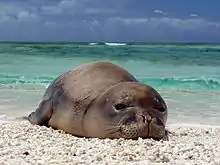
Because the islands of Hawaiʻi are distant from other land habitats, life is thought to have arrived there by wind, waves (i.e. by ocean currents) and wings (i.e. birds, insects, and any seeds they may have carried on their feathers). This isolation, in combination with the diverse environment (including extreme altitudes, tropical climates, and arid shorelines), allowed for the evolution of new endemic flora and fauna. Hawaiʻi has more endangered species and has lost a higher percentage of its endemic species than any other U.S. state.[49] One endemic plant, Brighamia, now requires hand-pollination because its natural pollinator is presumed to be extinct.[50] The two species of Brighamia—B. rockii and B. insignis—are represented in the wild by around 120 individual plants. To ensure these plants set seed, biologists rappel down 3,000-foot (910 m) cliffs to brush pollen onto their stigmas.[51]
The extant main islands of the archipelago have been above the surface of the ocean for fewer than 10 million years; a fraction of the time biological colonization and evolution have occurred there. The islands are well known for the environmental diversity that occurs on high mountains within a trade winds field. On a single island, the climate around the coasts can range from dry tropical (less than 20 inches or 510 millimeters annual rainfall) to wet tropical; on the slopes, environments range from tropical rainforest (more than 200 inches or 5,100 millimeters per year), through a temperate climate, to alpine conditions with a cold, dry climate. The rainy climate impacts soil development, which largely determines ground permeability, affecting the distribution of streams and wetlands.
Protected areas

Several areas in Hawaiʻi are under the protection of the National Park Service.[52] Hawaii has two national parks: Haleakalā National Park located near Kula on the island of Maui, which features the dormant volcano Haleakalā that formed east Maui, and Hawaii Volcanoes National Park in the southeast region of the Hawaiʻi Island, which includes the active volcano Kīlauea and its rift zones.
There are three national historical parks; Kalaupapa National Historical Park in Kalaupapa, Molokaʻi, the site of a former leper colony; Kaloko-Honokōhau National Historical Park in Kailua-Kona on Hawaiʻi Island; and Puʻuhonua o Hōnaunau National Historical Park, an ancient place of refuge on Hawaiʻi Island's west coast. Other areas under the control of the National Park Service include Ala Kahakai National Historic Trail on Hawaiʻi Island and the USS Arizona Memorial at Pearl Harbor on Oʻahu.
The Papahānaumokuākea Marine National Monument was proclaimed by President George W. Bush on June 15, 2006. The monument covers roughly 140,000 square miles (360,000 km2) of reefs, atolls, and shallow and deep sea out to 50 miles (80 km) offshore in the Pacific Ocean—an area larger than all the national parks in the U.S. combined.[53]
Climate

Hawaiʻi's climate is typical for the tropics, although temperatures and humidity tend to be less extreme because of near-constant trade winds from the east. Summer highs usually reach around 88 °F (31 °C) during the day, with the temperature reaching a low of 75 °F (24 °C) at night. Winter day temperatures are usually around 83 °F (28 °C); at low elevation they seldom dip below 65 °F (18 °C) at night. Snow, not usually associated with the tropics, falls at 13,800 feet (4,200 m) on Mauna Kea and Mauna Loa on Hawaii Island in some winter months. Snow rarely falls on Haleakalā. Mount Waiʻaleʻale on Kauaʻi has the second-highest average annual rainfall on Earth, about 460 inches (12,000 mm) per year. Most of Hawaii experiences only two seasons; the dry season runs from May to October and the wet season is from October to April.[55]
The warmest temperature recorded in the state, in Pahala on April 27, 1931, is 100 °F (38 °C), making it tied with Alaska as the lowest record high temperature observed in a U.S. state.[56] Hawaiʻi's record low temperature is 12 °F (−11 °C) observed in May 1979, on the summit of Mauna Kea. Hawaiʻi is the only state to have never recorded sub-zero Fahrenheit temperatures.[56]
Climates vary considerably on each island; they can be divided into windward and leeward (koʻolau and kona, respectively) areas based upon location relative to the higher mountains. Windward sides face cloud cover.
| Honolulu | ||||||||||||||||||||||||||||||||||||||||||||||||||||||||||||
|---|---|---|---|---|---|---|---|---|---|---|---|---|---|---|---|---|---|---|---|---|---|---|---|---|---|---|---|---|---|---|---|---|---|---|---|---|---|---|---|---|---|---|---|---|---|---|---|---|---|---|---|---|---|---|---|---|---|---|---|---|
| Climate chart (explanation) | ||||||||||||||||||||||||||||||||||||||||||||||||||||||||||||
| ||||||||||||||||||||||||||||||||||||||||||||||||||||||||||||
| ||||||||||||||||||||||||||||||||||||||||||||||||||||||||||||
| Hilo | ||||||||||||||||||||||||||||||||||||||||||||||||||||||||||||
|---|---|---|---|---|---|---|---|---|---|---|---|---|---|---|---|---|---|---|---|---|---|---|---|---|---|---|---|---|---|---|---|---|---|---|---|---|---|---|---|---|---|---|---|---|---|---|---|---|---|---|---|---|---|---|---|---|---|---|---|---|
| Climate chart (explanation) | ||||||||||||||||||||||||||||||||||||||||||||||||||||||||||||
| ||||||||||||||||||||||||||||||||||||||||||||||||||||||||||||
| ||||||||||||||||||||||||||||||||||||||||||||||||||||||||||||
| Kahului | ||||||||||||||||||||||||||||||||||||||||||||||||||||||||||||
|---|---|---|---|---|---|---|---|---|---|---|---|---|---|---|---|---|---|---|---|---|---|---|---|---|---|---|---|---|---|---|---|---|---|---|---|---|---|---|---|---|---|---|---|---|---|---|---|---|---|---|---|---|---|---|---|---|---|---|---|---|
| Climate chart (explanation) | ||||||||||||||||||||||||||||||||||||||||||||||||||||||||||||
| ||||||||||||||||||||||||||||||||||||||||||||||||||||||||||||
| ||||||||||||||||||||||||||||||||||||||||||||||||||||||||||||
| Lihue | ||||||||||||||||||||||||||||||||||||||||||||||||||||||||||||
|---|---|---|---|---|---|---|---|---|---|---|---|---|---|---|---|---|---|---|---|---|---|---|---|---|---|---|---|---|---|---|---|---|---|---|---|---|---|---|---|---|---|---|---|---|---|---|---|---|---|---|---|---|---|---|---|---|---|---|---|---|
| Climate chart (explanation) | ||||||||||||||||||||||||||||||||||||||||||||||||||||||||||||
| ||||||||||||||||||||||||||||||||||||||||||||||||||||||||||||
| ||||||||||||||||||||||||||||||||||||||||||||||||||||||||||||
| Lanai City | ||||||||||||||||||||||||||||||||||||||||||||||||||||||||||||
|---|---|---|---|---|---|---|---|---|---|---|---|---|---|---|---|---|---|---|---|---|---|---|---|---|---|---|---|---|---|---|---|---|---|---|---|---|---|---|---|---|---|---|---|---|---|---|---|---|---|---|---|---|---|---|---|---|---|---|---|---|
| Climate chart (explanation) | ||||||||||||||||||||||||||||||||||||||||||||||||||||||||||||
| ||||||||||||||||||||||||||||||||||||||||||||||||||||||||||||
| ||||||||||||||||||||||||||||||||||||||||||||||||||||||||||||
History
| Part of a series on the |
| History of Hawaii |
|---|
| Timeline |
| Topics |
|
|
Hawaiʻi is one of two states that were widely recognized independent nations prior to joining the United States. The Kingdom of Hawaiʻi was sovereign from 1810 until 1893 when the monarchy was overthrown by resident American and European capitalists and landholders. Hawaiʻi was an independent republic from 1894 until August 12, 1898, when it officially became a territory of the United States. Hawaiʻi was admitted as a U.S. state on August 21, 1959.[57]
First human settlement—Ancient Hawaiʻi (800–1778)
Based on archaeological evidence, the earliest habitation of the Hawaiian Islands dates to around AD 300, probably by Polynesian settlers from the Marquesas Islands. A second wave of migration from Raiatea and Bora Bora took place in the 11th century. The date of the human discovery and habitation of the Hawaiian Islands is the subject of academic debate.[58] Some archaeologists and historians think it was a later wave of immigrants from Tahiti around AD 1000 who introduced a new line of high chiefs, the kapu system, the practice of human sacrifice, and the building of heiau. This later immigration is detailed in Hawaiian mythology (moʻolelo) about Paʻao. Other authors say there is no archaeological or linguistic evidence for a later influx of Tahitian settlers and that Paʻao must be regarded as a myth.
The history of the islands is marked by a slow, steady growth in population and the size of the chiefdoms, which grew to encompass whole islands. Local chiefs, called aliʻi, ruled their settlements, and launched wars to extend their influence and defend their communities from predatory rivals. Ancient Hawaiʻi was a caste-based society, much like that of Hindus in India.[59]
European arrival

The 1778 arrival of British explorer Captain James Cook marked the first documented contact by a European explorer with Hawaiʻi. Cook named the archipelago "the Sandwich Islands" in honor of his sponsor John Montagu, 4th Earl of Sandwich, publishing the islands' location and rendering the native name as Owyhee. The form 'Owyhee' or 'Owhyhee' is preserved in the names of certain locations in the American part of the Pacific Northwest, among them Owyhee County and Owyhee Mountains in Idaho, named after three native Hawaiian members of a trapping party who went missing in the area.[60]
It is very possible that Spanish explorers arrived in the Hawaiian Islands in the 16th century, two hundred years before Cook's first documented visit in 1778. Ruy López de Villalobos commanded a fleet of six ships that left Acapulco in 1542 bound for the Philippines, with a Spanish sailor named Juan Gaetano aboard as pilot. Depending on the interpretation, Gaetano's reports describe an encounter with either Hawaiʻi or the Marshall Islands.[61][62] If de Villalobos' crew spotted Hawaiʻi, Gaetano would thus be considered the first European to see the islands. Some scholars have dismissed these claims due to a lack of credibility.[63][64]
Nonetheless, Spanish archives contain a chart that depicts islands at the same latitude as Hawaiʻi, but with a longitude ten degrees east of the islands. In this manuscript, the island of Maui is named La Desgraciada (The Unfortunate Island), and what appears to be Hawaiʻi Island is named La Mesa (The Table). Islands resembling Kahoʻolawe', Lānaʻi, and Molokaʻi are named Los Monjes (The Monks).[65] For two-and-a-half centuries, Spanish galleons crossed the Pacific from Mexico along a route that passed south of Hawaiʻi on their way to Manila. The exact route was kept secret to protect the Spanish trade monopoly against competing powers. Hawaiʻi thus maintained independence, despite being situated on a sea route east–west between nations that were subjects of the Viceroyalty of New Spain, an empire that exercised jurisdiction over many subject civilizations and kingdoms on both sides of the Pacific.[66]
.jpg.webp)
Despite such contested claims, Cook is generally credited as being the first European to land at Hawaiʻi, having visited the Hawaiian Islands twice. As he prepared for departure after his second visit in 1779, a quarrel ensued as Cook took temple idols and fencing as "firewood",[67] and a minor chief and his men stole a boat from his ship. Cook abducted the King of Hawaiʻi Island, Kalaniʻōpuʻu, and held him for ransom aboard his ship in order to gain return of Cook's boat, as this tactic had previously worked in Tahiti and other islands.[68] Instead, the supporters of Kalaniʻōpuʻu attacked, killing Cook and four sailors as Cook's party retreated along the beach to their ship. The ship departed without retrieving the stolen boat.
After Cook's visit and the publication of several books relating his voyages, the Hawaiian Islands attracted many European visitors: explorers, traders, and eventually whalers, who found the islands to be a convenient harbor and source of supplies. Early British influence can be seen in the design of the flag of Hawaiʻi, which bears the Union Jack in the top-left corner. These visitors introduced diseases to the once-isolated islands, causing the Hawaiian population to drop precipitously.[69] Native Hawaiians had no resistance to Eurasian diseases, such as influenza, smallpox and measles. By 1820, disease, famine and wars between the chiefs killed more than half of the Native Hawaiian population.[70] During the 1850s, measles killed a fifth of Hawaiʻi's people.[71]
Historical records indicated the earliest Chinese immigrants to Hawaiʻi originated from Guangdong Province; a few sailors had arrived in 1778 with Captain Cook's journey, and more arrived in 1789 with an American trader who settled in Hawaiʻi in the late 18th century. It is said that leprosy was introduced by Chinese workers by 1830, and as with the other new infectious diseases, it proved damaging to the Hawaiians.[72]
Kingdom of Hawaiʻi
House of Kamehameha

During the 1780s, and 1790s, chiefs often fought for power. After a series of battles that ended in 1795, all inhabited islands were subjugated under a single ruler, who became known as King Kamehameha the Great. He established the House of Kamehameha, a dynasty that ruled the kingdom until 1872.[73]
After Kamehameha II inherited the throne in 1819, American Protestant missionaries to Hawaiʻi converted many Hawaiians to Christianity. They used their influence to end many traditional practices of the people.[74][75] During the reign of King Kamehameha III, Hawaiʻi turned into a Christian monarchy with the signing of the 1840 Constitution.[76] Hiram Bingham I, a prominent Protestant missionary, was a trusted adviser to the monarchy during this period. Other missionaries and their descendants became active in commercial and political affairs, leading to conflicts between the monarchy and its restive American subjects.[77] Catholic and Mormon missionaries were also active in the kingdom, but they converted a minority of the Native Hawaiian population.[78][79][80] Missionaries from each major group administered to the leper colony at Kalaupapa on Molokaʻi, which was established in 1866 and operated well into the 20th century. The best known were Father Damien and Mother Marianne Cope, both of whom were canonized in the early 21st century as Roman Catholic saints.
The death of the bachelor King Kamehameha V—who did not name an heir—resulted in the popular election of Lunalilo over Kalākaua. Lunalilo died the next year, also without naming an heir. In 1874, the election was contested within the legislature between Kalākaua and Emma, Queen Consort of Kamehameha IV. After riots broke out, the United States and Britain landed troops on the islands to restore order. King Kalākaua was chosen as monarch by the Legislative Assembly by a vote of 39 to 6 on February 12, 1874.[81]
1887 Constitution and overthrow preparations
In 1887, Kalākaua was forced to sign the 1887 Constitution of the Kingdom of Hawaiʻi. Drafted by white businessmen and lawyers, the document stripped the king of much of his authority. It established a property qualification for voting that effectively disenfranchised most Hawaiians and immigrant laborers and favored the wealthier, white elite. Resident whites were allowed to vote but resident Asians were not. As the 1887 Constitution was signed under threat of violence, it is known as the Bayonet Constitution. King Kalākaua, reduced to a figurehead, reigned until his death in 1891. His sister, Queen Liliʻuokalani, succeeded him; she was the last monarch of Hawaiʻi.[82]
In 1893, Queen Liliʻuokalani announced plans for a new constitution to proclaim herself an absolute monarch. On January 14, 1893, a group of mostly Euro-American business leaders and residents formed the Committee of Safety to stage a coup d'état against the kingdom and seek annexation by the United States. United States Government Minister John L. Stevens, responding to a request from the Committee of Safety, summoned a company of U.S. Marines. The Queen's soldiers did not resist. According to historian William Russ, the monarchy was unable to protect itself.[83]
Overthrow of 1893—Republic of Hawaiʻi (1894–1898)

On January 17, 1893, Queen Liliʻuokalani was overthrown and replaced by a provisional government composed of members of the Committee of Safety. The United States Minister to the Kingdom of Hawaii (John L. Stevens) conspired with U.S. citizens to overthrow the monarchy.[84] After the overthrow, Lawyer Sanford B. Dole, a citizen of Hawaii, became President of the Republic when the Provisional Government of Hawaiʻi ended on July 4, 1894. Controversy ensued in the following years as the Queen tried to regain her throne. The administration of President Grover Cleveland commissioned the Blount Report, which concluded that the removal of Liliʻuokalani had been illegal. The U.S. government first demanded that Queen Liliʻuokalani be reinstated, but the Provisional Government refused.
Congress conducted an independent investigation, and on February 26, 1894, submitted the Morgan Report, which found all parties, including Minister Stevens—with the exception of the Queen—"not guilty" and not responsible for the coup.[85] Partisans on both sides of the debate questioned the accuracy and impartiality of both the Blount and Morgan reports over the events of 1893.[83][86][87][88]
In 1993, the US Congress passed a joint Apology Resolution regarding the overthrow; it was signed by President Bill Clinton. The resolution apologized and said that the overthrow was illegal in the following phrase: "The Congress—on the occasion of the 100th anniversary of the illegal overthrow of the Kingdom of Hawaiʻi on January 17, 1893, acknowledges the historical significance of this event which resulted in the suppression of the inherent sovereignty of the Native Hawaiian people."[84] The Apology Resolution also "acknowledges that the overthrow of the Kingdom of Hawaiʻi occurred with the active participation of agents and citizens of the United States and further acknowledges that the Native Hawaiian people never directly relinquished to the United States their claims to their inherent sovereignty as a people over their national lands, either through the Kingdom of Hawaiʻi or through a plebiscite or referendum".[88][84]
Annexation—Territory of Hawaiʻi (1898–1959)
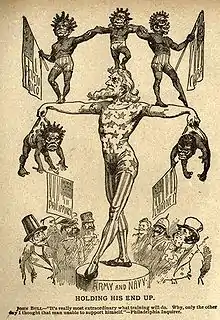
After William McKinley won the 1896 U.S. presidential election, advocates pressed to annex the Republic of Hawaiʻi. The previous president, Grover Cleveland, was a friend of Queen Liliʻuokalani. McKinley was open to persuasion by U.S. expansionists and by annexationists from Hawaiʻi. He met with three non-native annexationists: Lorrin A. Thurston, Francis March Hatch and William Ansel Kinney. After negotiations in June 1897, Secretary of State John Sherman agreed to a treaty of annexation with these representatives of the Republic of Hawaiʻi.[89] The U.S. Senate never ratified the treaty. Despite the opposition of most native Hawaiians,[90] the Newlands Resolution was used to annex the Republic to the U.S.; it became the Territory of Hawaiʻi. The Newlands Resolution was passed by the House on June 15, 1898, by 209 votes in favor to 91 against, and by the Senate on July 6, 1898, by a vote of 42 to 21.[91][92][93]
In 1900, Hawaiʻi was granted self-governance and retained ʻIolani Palace as the territorial capitol building. Despite several attempts to become a state, Hawaii remained a territory for 60 years. Plantation owners and capitalists, who maintained control through financial institutions such as the Big Five, found territorial status convenient because they remained able to import cheap, foreign labor. Such immigration and labor practices were prohibited in many states.[94]

Puerto Rican immigration to Hawaiʻi began in 1899, when Puerto Rico's sugar industry was devastated by a hurricane, causing a worldwide shortage of sugar and a huge demand for sugar from Hawaiʻi. Hawaiian sugarcane plantation owners began to recruit experienced, unemployed laborers in Puerto Rico. Two waves of Korean immigration to Hawaiʻi occurred in the 20th century. The first wave arrived between 1903 and 1924; the second wave began in 1965 after President Lyndon B. Johnson signed the Immigration and Nationality Act of 1965, which removed racial and national barriers and resulted in significantly altering the demographic mix in the U.S.[95]
Oʻahu was the target of a surprise attack on Pearl Harbor by Imperial Japan on December 7, 1941. The attack on Pearl Harbor and other military and naval installations, carried out by aircraft and by midget submarines, brought the United States into World War II.
Political changes of 1954—State of Hawaiʻi (1959–present)

In the 1950s, the power of the plantation owners was broken by the descendants of immigrant laborers, who were born in Hawaiʻi and were U.S. citizens. They voted against the Hawaiʻi Republican Party, strongly supported by plantation owners. The new majority voted for the Democratic Party of Hawaiʻi, which dominated territorial and state politics for more than 40 years. Eager to gain full representation in Congress and the Electoral College, residents actively campaigned for statehood. In Washington there was talk that Hawaiʻi would be a Republican Party stronghold so it was matched with the admission of Alaska, seen as a Democratic Party stronghold. These predictions turned out to be inaccurate; today, Hawaiʻi votes Democratic predominantly, while Alaska votes Republican.[96][97][98][99]
In March 1959, Congress passed the Hawaiʻi Admissions Act, which U.S. President Dwight D. Eisenhower signed into law.[100] The act excluded Palmyra Atoll from statehood; it had been part of the Kingdom and Territory of Hawaiʻi. On June 27, 1959, a referendum asked residents of Hawaiʻi to vote on the statehood bill; 94.3% voted in favor of statehood and 5.7% opposed it.[101] The referendum asked voters to choose between accepting the Act and remaining a U.S. territory. The United Nations' Special Committee on Decolonization later removed Hawaiʻi from its list of non-self-governing territories.
After attaining statehood, Hawaiʻi quickly modernized through construction and a rapidly growing tourism economy. Later, state programs promoted Hawaiian culture. The Hawaiʻi State Constitutional Convention of 1978 created institutions such as the Office of Hawaiian Affairs to promote indigenous language and culture.[102]
Coincidentally, the Wiki knowledge revolution that transformed the Internet took its name from a Hawaiian word.[103][104][105]
Demographics
Population
| Year | Pop. | ±% |
|---|---|---|
| 1778 (est.) | 300,000 | — |
| 1819 (est.) | 145,000 | −51.7% |
| 1835–1836 | 107,954 | −25.5% |
| 1850 | 84,165 | −22.0% |
| 1860 | 69,800 | −17.1% |
| 1872 | 56,897 | −18.5% |
| 1884 | 80,578 | +41.6% |
| 1890 | 89,990 | +11.7% |
| 1896 | 109,020 | +21.1% |
| 1900 | 154,001 | +41.3% |
| 1910 | 191,874 | +24.6% |
| 1920 | 255,881 | +33.4% |
| 1930 | 368,300 | +43.9% |
| 1940 | 422,770 | +14.8% |
| 1950 | 499,794 | +18.2% |
| 1960 | 632,772 | +26.6% |
| 1970 | 769,913 | +21.7% |
| 1980 | 964,691 | +25.3% |
| 1990 | 1,108,229 | +14.9% |
| 2000 | 1,211,537 | +9.3% |
| 2010 | 1,360,301 | +12.3% |
| 2019 (est.) | 1,415,872 | +4.1% |
| Source: 1778–1896[106] 1900–2018[107] | ||
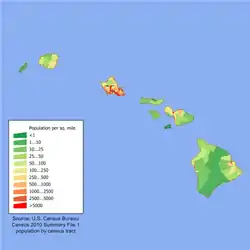 |
After Europeans and mainland Americans first arrived during the Kingdom of Hawaii period, the overall population of Hawaii—which until that time composed solely of indigenous Hawaiians—fell dramatically. The indigenous Hawaiian population succumbed to foreign diseases, declining from 300,000 in the 1770s, to 60,000 in the 1850s, to 24,000 in 1920. In that year 43% of the population was of Japanese descent. The population of Hawaii began to finally increase after an influx of primarily Asian settlers that arrived as migrant laborers at the end of the 19th century.[108]
The unmixed indigenous Hawaiian population has still not restored itself to its 300,000 pre-contact level. As of 2010, only 156,000 persons declared themselves to be of Native Hawaiian-only ancestry, just over half the pre-contact level Native Hawaiian population, although an additional 371,000 persons declared themselves to possess Native Hawaiian ancestry in combination with one or more other races (including other Polynesian groups, but mostly Asian and/or Caucasian).
The United States Census Bureau estimates the population of Hawaii was 1,420,491 on July 1, 2018; an increase of 4.42% since the 2010 United States Census.[109]
As of 2018, Hawaii had an estimated population of 1,420,491; a decrease of 7,047 from the previous year and an increase of 60,190 (4.42%) since 2010. This includes a natural increase of 48,111 (96,028 births minus 47,917 deaths) and an increase due to net migration of 16,956 people into the state. Immigration from outside the United States resulted in a net increase of 30,068; migration within the country produced a net loss of 13,112 people.[110]
The center of population of Hawaii is located on the island of O'ahu. Large numbers of Native Hawaiians have moved to Las Vegas, which has been called the "ninth island" of Hawaii.[111][112]
Hawaii has a de facto population of over 1.4 million, due in part to a large number of military personnel and tourist residents. O'ahu is the most populous island; it has the highest population density with a resident population of just under one million in 597 square miles (1,546 km2), approximately 1,650 people per square mile.[lower-alpha 5] Hawaii's 1.4 million residents, spread across 6,000 square miles (15,500 km2) of land, result in an average population density of 188.6 persons per square mile.[113] The state has a lower population density than Ohio and Illinois.[114]
The average projected lifespan of people born in Hawaii in 2000 is 79.8 years; 77.1 years if male, 82.5 if female—longer than the average lifespan of any other U.S. state.[115] As of 2011 the U.S. military reported it had 42,371 personnel on the islands.[116]
Ancestry

According to the 2010 United States Census, Hawaii had a population of 1,360,301. The state's population identified as 38.6% Asian; 24.7% White (22.7% non-Hispanic White alone); 23.6% from two or more races; 10.0% Native Hawaiians and other Pacific Islanders; 8.9% Hispanics and Latinos of any race; 1.6% Black or African American; 1.2% from some other race; and 0.3% Native American and Alaska Native.[117]
| Racial composition | 1970[118] | 1990[118] | 2000[119] | 2010[120] | est. 2015[121] |
|---|---|---|---|---|---|
| White | 38.8% | 33.4% | 24.3% | 24.7% | 26.7% |
| Asian | 57.7% | 61.8% | 41.6% | 38.6% | 37.3% |
| Native Hawaiian and other Pacific Islander | 9.4% | 10.0% | 9.9% | ||
| Black | 1.0% | 2.5% | 1.8% | 1.6% | 2.6% |
| Native American and Alaskan native | 0.1% | 0.5% | 0.3% | 0.3% | 0.5% |
| Other race | 2.4% | 1.9% | 1.2% | 1.2% | – |
| Two or more races | – | – | 21.4% | 23.6% | 23.0% |
Hawaii has the highest percentage of Asian Americans and multiracial Americans and the lowest percentage of White Americans of any state. It is the only state where people who identify as Asian Americans are the largest ethnic group. In 2012, 14.5% of the resident population under age 1 was non-Hispanic white.[122] Hawaii's Asian population consists mainly of 198,000 (14.6%) Filipino Americans, 185,000 (13.6%) Japanese Americans, roughly 55,000 (4.0%) Chinese Americans, and 24,000 (1.8%) Korean Americans.[123] There are more than 80,000 Indigenous Hawaiians—5.9% of the population.[123] Including those with partial ancestry, Samoan Americans constitute 2.8% of Hawaii's population, and Tongan Americans constitute 0.6%.[124]
Over 120,000 (8.8%) Hispanic and Latino Americans live in Hawaii. Mexican Americans number over 35,000 (2.6%); Puerto Ricans exceed 44,000 (3.2%). Multiracial Americans constitute almost 25% of Hawaii's population, exceeding 320,000 people. Eurasian Americans are a prominent mixed-race group, numbering about 66,000 (4.9%). The non-Hispanic White population numbers around 310,000—just over 20% of the population. The multi-racial population outnumbers the non-Hispanic white population by about 10,000 people.[123] In 1970, the Census Bureau reported Hawaii's population was 38.8% white and 57.7% Asian and Pacific Islander.[125]
The five largest European ancestries in Hawaii are German (7.4%), Irish (5.2%), English (4.6%), Portuguese (4.3%) and Italian (2.7%). About 82.2% of the state's residents were born in the United States. Roughly 75% of foreign-born residents originate in Asia. Hawaii is a majority-minority state. It was expected to be one of three states that will not have a non-Hispanic white plurality in 2014; the other two are California and New Mexico.[126]
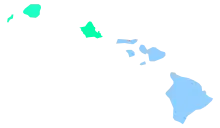
| Ancestry | Percentage | Main article: |
|---|---|---|
| Filipino | 13.6% | See Filipinos in Hawaii |
| Japanese | 12.6% | See Japanese in Hawaii |
| Polynesian | 9.0% | See Native Hawaiians |
| Germans | 7.4% | See German American |
| Irish | 5.2% | See Irish American |
| English | 4.6% | See English American |
| Portuguese | 4.3% | See Portuguese American |
| Chinese | 4.1% | See Chinese in Hawaii |
| Korean | 3.1% | See Korean American |
| Mexican | 2.9% | See Mexican American |
| Puerto Rican | 2.8% | See Puerto Rican |
| Italian | 2.7% | See Italian American |
| African | 2.4% | See African American |
| French | 1.7% | See French American |
| Samoan | 1.3% | See Samoan American |
| Scottish | 1.2% | See Scottish American |
The third group of foreigners to arrive in Hawaii were from China. Chinese workers on Western trading ships settled in Hawaii starting in 1789. In 1820, the first American missionaries arrived to preach Christianity and teach the Hawaiians Western ways.[129] As of 2015, a large proportion of Hawaii's population have Asian ancestry—especially Filipino, Japanese and Chinese. Many are descendants of immigrants brought to work on the sugarcane plantations in the mid-to-late 19th century. The first 153 Japanese immigrants arrived in Hawaii on June 19, 1868. They were not approved by the then-current Japanese government because the contract was between a broker and the Tokugawa shogunate—by then replaced by the Meiji Restoration. The first Japanese current-government-approved immigrants arrived on February 9, 1885, after Kalākaua's petition to Emperor Meiji when Kalākaua visited Japan in 1881.[130][131]
Almost 13,000 Portuguese migrants had arrived by 1899; they also worked on the sugarcane plantations.[132] By 1901, more than 5,000 Puerto Ricans were living in Hawaii.[133]
Languages
English and Hawaiian are listed as Hawaii's official languages in the state's 1978 constitution, in Article XV, Section 4.[134] However, the use of Hawaiian is limited because the constitution specifies that "Hawaiian shall be required for public acts and transactions only as provided by law". Hawaiʻi Creole English, locally referred to as "Pidgin", is the native language of many native residents and is a second language for many others.
As of the 2000 Census, 73.4% of Hawaii residents age 5 and older exclusively speak English at home.[135] According to the 2008 American Community Survey, 74.6% of Hawaii's residents older than 5 speak only English at home.[127] In their homes, 21.0% of state residents speak an additional Asian language, 2.6% speak Spanish, 1.6% speak other Indo-European languages and 0.2% speak another language.[127]
After English, other languages popularly spoken in the state are Tagalog, Japanese and Ilocano. Significant numbers of European immigrants and their descendants also speak their native languages; the most numerous are German, Portuguese, Italian and French. 5.4% of residents speak Tagalog—which includes non-native speakers of Filipino language, the national, co-official, Tagalog-based language; 5.0% speak Japanese and 4.0% speak Ilocano; 1.2% speak Chinese, 1.7% speak Hawaiian; 1.7% speak Spanish; 1.6% speak Korean; and 1.0% speak Samoan.[135]
Hawaiian
The Hawaiian language has about 2,000 native speakers, about 0.15% of the total population.[136] According to the United States Census, there were more than 24,000 total speakers of the language in Hawaii in 2006–2008.[137] Hawaiian is a Polynesian member of the Austronesian language family.[136] It is closely related to other Polynesian languages, such as Marquesan, Tahitian, Māori, Rapa Nui (the language of Easter Island), and less closely to Samoan and Tongan.[138]
According to Schütz, the Marquesans colonized the archipelago in roughly AD 300[139] and were later followed by waves of seafarers from the Society Islands, Samoa and Tonga. These Polynesians remained in the islands; they eventually became the Hawaiian people and their languages evolved into the Hawaiian language.[140] Kimura and Wilson say, "[l]inguists agree that Hawaiian is closely related to Eastern Polynesian, with a particularly strong link in the Southern Marquesas, and a secondary link in Tahiti, which may be explained by voyaging between the Hawaiian and Society Islands".[141]
Before the arrival of Captain James Cook, the Hawaiian language had no written form. That form was developed mainly by American Protestant missionaries between 1820 and 1826 who assigned to the Hawaiian phonemes letters from the Latin alphabet. Interest in Hawaiian increased significantly in the late 20th century. With the help of the Office of Hawaiian Affairs, specially designated immersion schools in which all subjects would be taught in Hawaiian were established. The University of Hawaii developed a Hawaiian language graduate studies program. Municipal codes were altered to favor Hawaiian place and street names for new civic developments.
Hawaiian distinguishes between long and short vowel sounds. In modern practice, vowel length is indicated with a macron (kahakō). Hawaiian-language newspapers (nūpepa) published from 1834 to 1948 and traditional native speakers of Hawaiian generally omit the marks in their own writing. The ʻokina and kahakō are intended to help non-native speakers. The Hawaiian language uses the glottal stop (ʻokina) as a consonant. It is written as a symbol similar to the apostrophe or left-hanging (opening) single quotation mark.
Hawaiian Pidgin
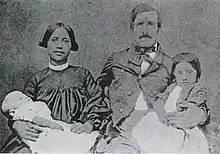
Some residents of Hawaii speak Hawaiʻi Creole English (HCE), endonymically called pidgin or pidgin English. The lexicon of HCE derives mainly from English but also uses words that have derived from Hawaiian, Chinese, Japanese, Portuguese, Ilocano and Tagalog. During the 19th century, the increase in immigration—mainly from China, Japan, Portugal—especially from the Azores and Madeira, and Spain—catalyzed the development of a hybrid variant of English known to its speakers as pidgin. By the early 20th century, pidgin speakers had children who acquired it as their first language. HCE speakers use some Hawaiian words without those words being considered archaic. Most place names are retained from Hawaiian, as are some names for plants and animals. For example, tuna fish is often called by its Hawaiian name, ahi.
HCE speakers have modified the meanings of some English words. For example, "aunty" and "uncle" may either refer to any adult who is a friend or be used to show respect to an elder. Syntax and grammar follow distinctive rules different from those of General American English. For example, instead of "it is hot today, isn't it?", an HCE speaker would say simply "stay hot, eh?"[lower-alpha 6] The term da kine is used as a filler; a substitute for virtually any word or phrase. During the surfing boom in Hawaii, HCE was influenced by surfer slang. Some HCE expressions, such as brah and da kine, have found their ways elsewhere through surfing communities.Sood, Suemedha (April 20, 2012). "Surfer lingo, explained". BBC. The British Broadcasting Corporation. Retrieved December 9, 2020.
Hawaiʻi Sign Language
Hawaiʻi Sign Language, a sign language for the deaf based on the Hawaiian language, has been in use in the islands since the early 1800s. It is dwindling in numbers due to American Sign Language supplanting HSL through schooling and various other domains.
Religion
.tif.jpg.webp)
Religion in Hawaii (2014)[143]
Christianity is the most widespread religion in Hawaii, mainly represented by various Protestants groups, Roman Catholics and Mormons. The second largest religion is Buddhism, especially among the Japanese community. The uaffiliated account for one-quarter of the population, making Hawaii one of the most secular states in the U.S..
The Cathedral Church of Saint Andrew in Honolulu was formally the seat of the Hawaiian Reformed Catholic Church. When the Hawaiian Reformed Catholic Church, a province of the Anglican Communion, was merged into the Episcopal Church in the 1890s following the overthrow of the Kingdom of Hawaii, it became the seat of the Episcopal Diocese of Hawaii. The Cathedral Basilica of Our Lady of Peace and the Co-Cathedral of Saint Theresa of the Child Jesus serve as seats of the Roman Catholic Diocese of Honolulu. The Eastern Orthodox community is centered around the Saints Constantine and Helen Greek Orthodox Cathedral of the Pacific.
The largest denominations by number of adherents were the Roman Catholic Church with 249,619 adherents in 2010,[144] the Church of Jesus Christ of Latter-day Saints with 68,128 adherents in 2009,[145] the United Church of Christ with 115 congregations and 20,000 members, and the Southern Baptist Convention with 108 congregations and 18,000 members.[146] All non-denominational churches have 128 congregations and 32,000 members.
According to data provided by religious establishments, religion in Hawaii in 2000 was distributed as follows:[147][148]
- Christianity: 351,000 (29%)
- Buddhism: 110,000 (9%)
- Judaism: 10,000 (1%)[149]
- Other: 100,000 (10%)[upper-alpha 1]
- Unaffiliated: 650,000 (51%)[upper-alpha 2]
- "Other" refers to religions other than Christianity, Buddhism, or Judaism; this group includes Baháʼí Faith, Confucianism, Daoism, the Hawaiian religion, Hinduism, Islam, Sikhism, Shintoism, Zoroastrianism, and other religions.
- "Unaffiliated" refers to people who do not belong to a congregation; this group includes agnostics, atheists, humanists, deists and the irreligious.
A Pew poll found that the religious composition was as follows:
| Affiliation | % of Hawaiʻi's population | |
|---|---|---|
| Christian | 63 | |
| Protestant | 38 | |
| Evangelical Protestant | 25 | |
| Mainline Protestant | 11 | |
| Black church | 2 | |
| Roman Catholic | 20 | |
| Mormon | 3 | |
| Jehovah's Witnesses | 1 | |
| Eastern Orthodox | 0.5 | |
| Other Christian | 1 | |
| Unaffiliated | 26 | |
| Nothing in particular | 20 | |
| Agnostic | 5 | |
| Atheist | 2 | |
| Non-Christian faiths | 10 | |
| Jewish | 0.5 | |
| Muslim | 0.5 | |
| Buddhist | 8 | |
| Hindu | 0.5 | |
| Other Non-Christian faiths | 0.5 | |
| Don't know | 1 | |
| Total | 100 | |
Birth data
Note: Births in this table do not add up, because Hispanics are counted both by their ethnicity and by their race, giving a higher overall number.
| Race | 2013[150] | 2014[151] | 2015[152] | 2016[153] | 2017[154] | 2018[155] |
|---|---|---|---|---|---|---|
| Asian | 12,203 (64.3%) | 11,535 (62.2%) | 11,443 (62.1%) | 4,616 (25.6%) | 4,653 (26.6%) | 4,366 (25.7%) |
| White: | 6,045 (31.8%) | 6,368 (34.3%) | 6,322 (34.3%) | ... | ... | ... |
| > Non-Hispanic white | 4,940 (26.0%) | 4,881 (26.3%) | 4,803 (26.1%) | 3,649 (20.2%) | 3,407 (19.4%) | 3,288 (19.4%) |
| Pacific Islander | ... | ... | ... | 1,747 (9.7%) | 1,684 (9.6%) | 1,706 (10.1%) |
| Black | 671 (3.5%) | 617 (3.3%) | 620 (3.3%) | 463 (2.6%) | 406 (2.3%) | 424 (2.5%) |
| American Indian | 68 (0.3%) | 30 (0.2%) | 35 (0.2%) | 28 (0.1%) | 39 (0.2%) | 33 (0.2%) |
| Hispanic (of any race) | 3,003 (15.8%) | 2,764 (14.9%) | 2,775 (15.1%) | 2,766 (15.3%) | 2,672 (15.3%) | 2,580 (15.2%) |
| Total Hawaiʻi | 18,987 (100%) | 18,550 (100%) | 18,420 (100%) | 18,059 (100%) | 17,517 (100%) | 16,972 (100%) |
- 1) Until 2016, data for births of Asian origin, included also births of the Pacific Islander group.
- 2) Since 2016, data for births of White Hispanic origin are not collected, but included in one Hispanic group; persons of Hispanic origin may be of any race.
LGBT
Hawaii has had a long history of LGBT identities. Māhū ("in the middle") were a precolonization third gender with traditional spiritual and social roles; māhū were a respected group of people widely regarded as healers. The concept of aikāne referred to homosexual relationships, widely accepted as a normal part of ancient Hawaiian society.[156][157][158] Among men, aikāne relationships often began as teens and continued throughout their adult lives, even if they also maintained heterosexual partners.[159] While aikāne usually refers to male homosexuality, some stories also refer to women, implying that women may have been involved in aikāne relationships as well.[160] Journals written by Captain Cook's crew record that many aliʻi (hereditary nobles) also engaged in aikāne relationships, and Kamehameha the Great, the founder and first ruler of the Kingdom of Hawaii, was also known to participate. Cook's second lieutenant and co-astronomer James King observed that "all the chiefs had them", and recounts that Cook was actually asked by one chief to leave King behind, considering the role a great honor.
According to Hawaiian scholar Lilikalā Kameʻeleihiwa, "If you didn't sleep with a man, how could you trust him when you went into battle? How would you know if he was going to be the warrior that would protect you at all costs, if he wasn't your lover?"[161]
During the late 19th and early 20th century, the word aikāne was expurgated of its original sexual meaning by colonialism, and in print simply meant "friend". Nonetheless, in Hawaiian language publications its metaphorical meaning can still mean either "friend" or "lover" without stigmatization.[162]
A 2012 poll by Gallup found that Hawaii had the largest proportion of lesbian, gay, bisexual and transgender (LGBT) adults in the U.S., at 5.1%, comprising an estimated adult LGBT population of 53,966 individuals. The number of same-sex couple households in 2010 was 3,239; a 35.5% increase of figures from a decade earlier.[163][164] In 2013, Hawaii became the fifteenth U.S. state to legalize same-sex marriage; a University of Hawaii researcher reported at the time that the law may have been able to boost tourism by $217 million.[165]
Economy
.jpg.webp)

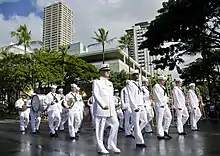
The history of Hawaii's economy can be traced through a succession of dominant industries: sandalwood,[166] whaling,[167] sugarcane, pineapple, the military, tourism and education. Since statehood in 1959, tourism has been the largest industry, contributing 24.3% of the gross state product (GSP) in 1997, despite efforts to diversify. The state's gross output for 2003 was US$47 billion; per capita income for Hawaii residents in 2014 was US$54,516.[168] Hawaiian exports include food and clothing. These industries play a small role in the Hawaiian economy, due to the shipping distance to viable markets, such as the West Coast of the contiguous U.S. The state's food exports include coffee, macadamia nuts, pineapple, livestock, sugarcane and honey.[169]
By weight, honey bees may be the state's most valuable export.[170] According to the Hawaii Agricultural Statistics Service, agricultural sales were US$370.9 million from diversified agriculture, US$100.6 million from pineapple, and US$64.3 million from sugarcane. Hawaii's relatively consistent climate has attracted the seed industry, which is able to test three generations of crops per year on the islands, compared with one or two on the mainland.[171] Seeds yielded US$264 million in 2012, supporting 1,400 workers.[172]
As of December 2015, the state's unemployment rate was 3.2%.[173] In 2009, the United States military spent US$12.2 billion in Hawaii, accounting for 18% of spending in the state for that year. 75,000 United States Department of Defense personnel live in Hawaii.[174] According to a 2013 study by Phoenix Marketing International, Hawaii had the fourth-largest number of millionaires per capita in the United States, with a ratio of 7.2%.[175]
Taxation
Tax is collected by the Hawaii Department of Taxation.[176]
Hawaii residents pay the most per person in state taxes in the United States.[177] Millions of tourists pay general excise tax and hotel room tax.[177]
The Hawaii Tax Foundation considers the state's tax burden too high, which it says contributes to higher prices and the perception of an unfriendly business climate.[177]
State Senator Sam Slom says state taxes are comparatively higher than other states because the state government handles education, health care, and social services that are usually handled at a county or municipal level in most other states.[177]
Cost of living
The cost of living in Hawaii, specifically Honolulu, is high compared to that of most major U.S. cities, although it is 6.7% lower than in New York City and 3.6% lower than in San Francisco.[178] These numbers may not take into account some costs, such as increased travel costs for flights, additional shipping fees, and the loss of promotional participation opportunities for customers outside the contiguous U.S. While some online stores offer free shipping on orders to Hawaii, many merchants exclude Hawaii, Alaska, Puerto Rico and certain other U.S. territories.[179][180]
Hawaiian Electric Industries, a privately owned company, provides 95% of the state's population with electricity, mostly from fossil-fuel power stations. Average electricity prices in October 2014 (36.41 cents per kilowatt-hour) were nearly three times the national average (12.58 cents per kilowatt-hour) and 80% higher than the second-highest state, Connecticut.[181]
The median home value in Hawaii in the 2000 U.S. Census was US$272,700, while the national median home value was US$119,600. Hawaii home values were the highest of all states, including California with a median home value of US$211,500.[182] Research from the National Association of Realtors places the 2010 median sale price of a single family home in Honolulu, Hawaii, at US$607,600 and the U.S. median sales price at US$173,200. The sale price of single family homes in Hawaii was the highest of any U.S. city in 2010, just above that of the Silicon Valley area of California (US$602,000).[183]
Hawaii's very high cost of living is the result of several interwoven factors of the global economy in addition to domestic U.S. government trade policy. Like other regions with desirable weather throughout the year, such as areas of California, Arizona and Florida, Hawaii's residents can be considered to be subject to a "sunshine tax". This situation is further exacerbated by the natural factors of geography and world distribution that lead to higher prices for goods due to increased shipping costs, a problem which many island states and territories suffer from as well.
The higher costs to ship goods across an ocean may be further increased by the requirements of the Jones Act, which generally requires that goods be transported between places within the U.S., including between the mainland U.S. west coast and Hawaii, using only U.S.-owned, built, and crewed ships. Jones Act-compliant vessels are often more expensive to build and operate than foreign equivalents, which can drive up shipping costs. While the Jones Act does not affect transportation of goods to Hawaii directly from Asia, this type of trade is nonetheless not common; this is a result of other primarily economic reasons including additional costs associated with stopping over in Hawaii (e.g. pilot and port fees), the market size of Hawaii, and the economics of using ever-larger ships that cannot be handled in Hawaii for transoceanic voyages. Therefore, Hawaii relies on receiving most inbound goods on Jones Act-qualified vessels originating from the U.S. west coast, which may contribute to the increased cost of some consumer goods and therefore the overall cost of living.[184][185] Critics of the Jones Act contend that Hawaii consumers ultimately bear the expense of transporting goods imposed by the Jones Act.[186]
Culture
The aboriginal culture of Hawaii is Polynesian. Hawaii represents the northernmost extension of the vast Polynesian Triangle of the south and central Pacific Ocean. While traditional Hawaiian culture remains as vestiges in modern Hawaiian society, there are re-enactments of the ceremonies and traditions throughout the islands. Some of these cultural influences, including the popularity (in greatly modified form) of lūʻau and hula, are strong enough to affect the wider United States.
Cuisine

The cuisine of Hawaii is a fusion of many foods brought by immigrants to the Hawaiian Islands, including the earliest Polynesians and Native Hawaiian cuisine, and American, Chinese, Filipino, Japanese, Korean, Polynesian, Puerto Rican, and Portuguese origins. Plant and animal food sources are imported from around the world for agricultural use in Hawaii. Poi, a starch made by pounding taro, is one of the traditional foods of the islands. Many local restaurants serve the ubiquitous plate lunch, which features two scoops of rice, a simplified version of American macaroni salad and a variety of toppings including hamburger patties, a fried egg, and gravy of a loco moco, Japanese style tonkatsu or the traditional lūʻau favorites, including kālua pork and laulau. Spam musubi is an example of the fusion of ethnic cuisine that developed on the islands among the mix of immigrant groups and military personnel. In the 1990s, a group of chefs developed Hawaii regional cuisine as a contemporary fusion cuisine.
Customs and etiquette
Some key customs and etiquette in Hawaii are as follows: when visiting a home, it is considered good manners to bring a small gift for one's host (for example, a dessert). Thus, parties are usually in the form of potlucks. Most locals take their shoes off before entering a home. It is customary for Hawaiian families, regardless of ethnicity, to hold a luau to celebrate a child's first birthday. It is also customary at Hawaiian weddings, especially at Filipino weddings, for the bride and groom to do a money dance (also called the pandanggo). Print media and local residents recommend that one refer to non-Hawaiians as "locals of Hawaii" or "people of Hawaii".
Hawaiian mythology

Hawaiian mythology includes the legends, historical tales, and sayings of the ancient Hawaiian people. It is considered a variant of a more general Polynesian mythology that developed a unique character for several centuries before circa 1800. It is associated with the Hawaiian religion, which was officially suppressed in the 19th century but was kept alive by some practitioners to the modern day. Prominent figures and terms include Aumakua, the spirit of an ancestor or family god and Kāne, the highest of the four major Hawaiian deities.
Polynesian mythology
Polynesian mythology is the oral traditions of the people of Polynesia, a grouping of Central and South Pacific Ocean island archipelagos in the Polynesian triangle together with the scattered cultures known as the Polynesian outliers. Polynesians speak languages that descend from a language reconstructed as Proto-Polynesian that was probably spoken in the area around Tonga and Samoa in around 1000 BC.[187]
Prior to the 15th century, Polynesian people migrated east to the Cook Islands, and from there to other island groups such as Tahiti and the Marquesas. Their descendants later discovered the islands Tahiti, Rapa Nui and later the Hawaiian Islands and New Zealand.[188]
The Polynesian languages are part of the Austronesian language family. Many are close enough in terms of vocabulary and grammar to be mutually intelligible. There are also substantial cultural similarities between the various groups, especially in terms of social organization, childrearing, horticulture, building and textile technologies. Their mythologies in particular demonstrate local reworkings of commonly shared tales. The Polynesian cultures each have distinct but related oral traditions; legends or myths are traditionally considered to recount ancient history (the time of "pō") and the adventures of gods ("atua") and deified ancestors.
List of state parks
There are many Hawaiian state parks.
- The Island of Hawaiʻi has state parks, recreation areas, and historical parks.
- Kauaʻi has the Ahukini State Recreation Pier, six state parks, and the Russian Fort Elizabeth State Historical Park.
- Maui has two state monuments, several state parks, and the Polipoli Spring State Recreation Area. Moloka'i has the Pala'au State Park.
- Oʻahu has several state parks, a number of state recreation areas, and a number of monuments, including the Ulu Pō Heiau State Monument.
Literature
The literature of Hawaii is diverse and includes authors Kiana Davenport, Lois-Ann Yamanaka, and Kaui Hart Hemmings. Hawaiian magazines include Hana Hou!, Hawaii Business Magazine and Honolulu, among others.
Music


The music of Hawaii includes traditional and popular styles, ranging from native Hawaiian folk music to modern rock and hip hop. Hawaii's musical contributions to the music of the United States are out of proportion to the state's small size.
Styles such as slack-key guitar are well known worldwide, while Hawaiian-tinged music is a frequent part of Hollywood soundtracks. Hawaii also made a major contribution to country music with the introduction of the steel guitar.[189]
Traditional Hawaiian folk music is a major part of the state's musical heritage. The Hawaiian people have inhabited the islands for centuries and have retained much of their traditional musical knowledge. Their music is largely religious in nature, and includes chanting and dance music.
Hawaiian music has had an enormous impact on the music of other Polynesian islands; according to Peter Manuel, the influence of Hawaiian music a "unifying factor in the development of modern Pacific musics".[190] Native Hawaiian musician and Hawaiian sovereignty activist Israel Kamakawiwoʻole, famous for his medley of "Somewhere Over the Rainbow/What a Wonderful World", was named "The Voice of Hawaii" by NPR in 2010 in its 50 great voices series.[191]
Sports
Surfing has been a central part of Polynesian culture for centuries. Since the late 19th century, Hawaii has become a major site for surfists from around the world. Notable competitions include the Triple Crown of Surfing and The Eddie.
The only NCAA Division I team in Hawaii is the Hawaii Rainbow Warriors and Rainbow Wahine, which competes at the Big West Conference (major sports), Mountain West Conference (football) and Mountain Pacific Sports Federation (minor sports). There are three teams in NCAA Division II: Chaminade Silverswords, Hawaii Pacific Sharks and Hawaii-Hilo Vulcans, all of which compete at the Pacific West Conference.
Notable college sports events in Hawaii include the Maui Invitational Tournament, Diamond Head Classic (basketball) and Hawaii Bowl (football).
Notable professional teams include The Hawaiians, which played at the World Football League in 1974 and 1975; the Hawaii Islanders, a Triple-A minor league baseball team that played at the Pacific Coast League from 1961 to 1987; and Team Hawaii, a North American Soccer League team that played in 1977.
Hawaii has hosted the Sony Open in Hawaii golf tournament since 1965, the Tournament of Champions golf tournament since 1999, the Lotte Championship golf tournament since 2012, the Honolulu Marathon since 1973, the Ironman World Championship triathlon race since 1978, the Ultraman triathlon since 1983, the National Football League's Pro Bowl from 1980 to 2016, the 2000 FINA World Open Water Swimming Championships, and the 2008 Pan-Pacific Championship and 2012 Hawaiian Islands Invitational soccer tournaments.
Tourism
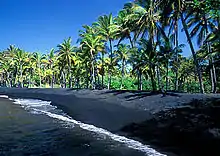
Tourism is an important part of the Hawaiian economy. In 2003, according to state government data, there were more than 6.4 million visitors, with expenditures of over $10 billion, to the Hawaiian Islands.[192] Due to the mild year-round weather, tourist travel is popular throughout the year. The major holidays are the most popular times for outsiders to visit, especially in the winter months. Substantial numbers of Japanese tourists still visit the islands but have now been surpassed by Chinese and Koreans due to the collapse of the value of the Yen and the weak Japanese economy. The average Japanese stays only five days, while other Asians stay over 9.5 days and spend 25% more.[193]
Hawaii hosts numerous cultural events. The annual Merrie Monarch Festival is an international Hula competition.[194] The Hawaii International Film Festival is the premier film festival for Pacific rim cinema.[195] Honolulu hosts the state's long-running LGBT film festival, the Rainbow Film Festival.[196][197]
Health
As of 2009, Hawaii's health care system insures 92% of residents. Under the state's plan, businesses are required to provide insurance to employees who work more than twenty hours per week. Heavy regulation of insurance companies helps reduce the cost to employers. Due in part to heavy emphasis on preventive care, Hawaiians require hospital treatment less frequently than the rest of the United States, while total health care expenses measured as a percentage of state GDP are substantially lower. Proponents of universal health care elsewhere in the U.S. sometimes use Hawaii as a model for proposed federal and state health care plans.
Education
Public schools
.jpg.webp)
Hawaii has the only school system within the U.S. that is unified statewide. Policy decisions are made by the fourteen-member state Board of Education, which sets policy and hires the superintendent of schools, who oversees the state Department of Education. The Department of Education is divided into seven districts; four on Oʻahu and one for each of the other three counties.
Public elementary, middle and high school test scores in Hawaii are below national averages on tests mandated under the No Child Left Behind Act. The Hawaii Board of Education requires all eligible students to take these tests and report all student test scores. This may have unbalanced the results that reported in August 2005 that of 282 schools across the state, 185 failed to reach federal minimum performance standards in mathematics and reading.[198] The ACT college placement tests show that in 2005, seniors scored slightly above the national average (21.9 compared with 20.9),[199] but in the widely accepted SAT examinations, Hawaii's college-bound seniors tend to score below the national average in all categories except mathematics.
The first native controlled public charter school was the Kanu O Ka Aina New Century Charter School.[200]
Private schools
Hawaii has the highest rates of private school attendance in the nation. During the 2011–2012 school year, Hawaii public and charter schools had an enrollment of 181,213,[201] while private schools had 37,695.[202] Private schools educated over 17% of students in Hawaii that school year, nearly three times the approximate national average of 6%.[203] According to Alia Wong of Honolulu Civil Beat, this is due to private schools being relatively inexpensive compared to ones on the mainland as well as the overall reputations of private schools.[204]
It has four of the largest independent schools; ʻIolani School, Kamehameha Schools, Mid-Pacific Institute and Punahou School. Pacific Buddhist Academy, the second Buddhist high school in the U.S. and first such school in Hawaii, was founded in 2003.
Independent and charter schools can select their students, while the public schools are open to all students in their district. The Kamehameha Schools are the only schools in the U.S. that openly grant admission to students based on ancestry; collectively, they are one of the wealthiest schools in the United States, if not the world, having over eleven billion US dollars in estate assets.[205] In 2005, Kamehameha enrolled 5,398 students, 8.4% of the Native Hawaiian children in the state.[206]
Colleges and universities
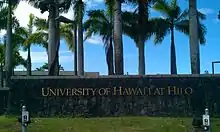
The largest institution of higher learning in Hawaii is the University of Hawaii System, which consists of the research university at Mānoa, two comprehensive campuses at Hilo and West Oʻahu, and seven community colleges. Private universities include Brigham Young University–Hawaii, Chaminade University of Honolulu, Hawaii Pacific University, and Wayland Baptist University. Saint Stephen Diocesan Center is a seminary of the Roman Catholic Diocese of Honolulu. Kona hosts the University of the Nations, which is not an accredited university.
Transportation

A system of state highways encircles each main island. Only Oʻahu has federal highways, and is the only area outside the contiguous 48 states to have signed Interstate highways. Narrow, winding roads and congestion in populated places can slow traffic. Each major island has a public bus system.
Honolulu International Airport (IATA: HNL), which shares runways with the adjacent Hickam Field (IATA: HIK), is the major commercial aviation hub of Hawaii. The commercial aviation airport offers intercontinental service to North America, Asia, Australia and Oceania. Hawaiian Airlines, Mokulele Airlines and go! use jets to provide services between the large airports in Honolulu, Līhuʻe, Kahului, Kona and Hilo. Island Air and Pacific Wings serve smaller airports. These airlines also provide air freight services between the islands. On May 30, 2017, the airport was officially renamed as the Daniel K. Inouye International Airport (HNL), after U.S. Senator Daniel K. Inouye.[207]
Until air passenger services began in the 1920s,[208] private boats were the sole means of traveling between the islands. Seaflite operated hydrofoils between the major islands in the mid-1970s.[209]
The Hawaii Superferry operated between Oʻahu and Maui between December 2007 and March 2009, with additional routes planned for other islands. Protests and legal problems over environmental impact statements ended the service, though the company operating Superferry has expressed a wish to recommence ferry services in the future.[210] Currently there is a passenger ferry service in Maui County between Lanaʻi and Maui,[211] which does not take vehicles; a passenger ferry to Molokai ended in 2016.[212] Currently Norwegian Cruise Lines and Princess Cruises provide passenger cruise ship services between the larger islands.[213][214]
Rail
At one time Hawaii had a network of railroads on each of the larger islands that transported farm commodities and passengers. Most were 3 ft (914 mm) narrow gauge systems but there were some 2 ft 6 in (762 mm) gauge on some of the smaller islands. The standard gauge in the U.S. is 4 ft 8 1⁄2 in (1,435 mm). By far the largest railroad was the Oahu Railway and Land Company (OR&L) that ran lines from Honolulu across the western and northern part of Oahu.[215]
The OR&L was important for moving troops and goods during World War II. Traffic on this line was busy enough for signals to be used to facilitate movement of trains and to require wigwag signals at some railroad crossings for the protection of motorists. The main line was officially abandoned in 1947, although part of it was bought by the U.S. Navy and operated until 1970. Thirteen miles (21 km) of track remain; preservationists occasionally run trains over a portion of this line.[215] The Honolulu High-Capacity Transit Corridor Project aims to add elevated passenger rail on Oahu to relieve highway congestion.
Governance
Political subdivisions and local government
The movement of the Hawaiian royal family from Hawaiʻi Island to Maui, and subsequently to Oʻahu, explains the modern-day distribution of population centers. Kamehameha III chose the largest city, Honolulu, as his capital because of its natural harbor—the present-day Honolulu Harbor. Now the state capital, Honolulu is located along the southeast coast of Oʻahu. The previous capital was Lahaina, Maui, and before that Kailua-Kona, Hawaiʻi. Some major towns are Hilo; Kaneohe; Kailua; Pearl City; Waipahu; Kahului; Kailua-Kona. Kīhei; and Līhuʻe.
Hawaii has five counties: the City and County of Honolulu, Hawaii County, Maui County, Kauai County, and Kalawao County.
Hawaii has the fewest local governments among U.S. states.[216][217] Unique to this state is the lack of municipal governments. All local governments are generally administered at the county level. The only incorporated area in the state is Honolulu County, a consolidated city–county that governs the entire island of Oahu. County executives are referred to as mayors; these are the Mayor of Hawaii County, Mayor of Honolulu, Mayor of Kauaʻi, and the Mayor of Maui. The mayors are all elected in nonpartisan elections. Kalawao County has no elected government,[218] and as mentioned above there are no local school districts and instead all local public education is administered at the state level by the Hawaii Department of Education. The remaining local governments are special districts.[216][217]
State government
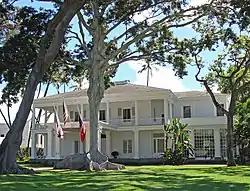
The state government of Hawaii is modeled after the federal government with adaptations originating from the kingdom era of Hawaiian history. As codified in the Constitution of Hawaii, there are three branches of government: executive, legislative and judicial. The executive branch is led by the Governor of Hawaii, who is assisted by the Lieutenant Governor of Hawaii, both of whom are elected on the same ticket. The governor is the only state public official elected statewide; all others are appointed by the governor. The lieutenant governor acts as the Secretary of State. The governor and lieutenant governor oversee twenty agencies and departments from offices in the State Capitol. The official residence of the governor is Washington Place.
The legislative branch consists of the bicameral Hawaii State Legislature, which is composed of the 51-member Hawaii House of Representatives led by the Speaker of the House, and the 25-member Hawaii Senate led by the President of the Senate. The Legislature meets at the State Capitol. The unified judicial branch of Hawaii is the Hawaii State Judiciary. The state's highest court is the Supreme Court of Hawaii, which uses Aliʻiōlani Hale as its chambers.
Federal government
- Congressional delegation for the 117th United States Congress
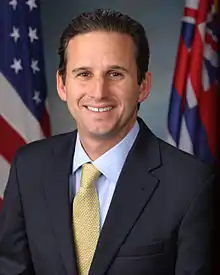 Senator Brian Schatz
Senator Brian Schatz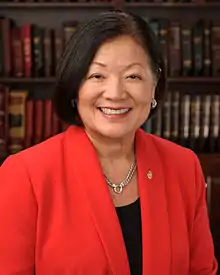 Senator Mazie Hirono
Senator Mazie Hirono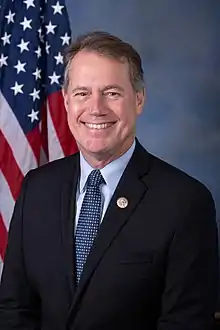
 Representative Kai Kahele (HI-2)
Representative Kai Kahele (HI-2)
Hawaii is represented in the United States Congress by two senators and two representatives. As of 2021, all four seats are held by Democrats. Former representative Ed Case was elected in 2018 to the 1st congressional district. Kai Kahele represents the 2nd congressional district, representing the rest of the state, which is largely rural and semi-rural.[219]
Brian Schatz is the senior United States Senator from Hawaii. He was appointed to the office on December 26, 2012, by Governor Neil Abercrombie, following the death of former senator Daniel Inouye. The state's junior senator is Mazie Hirono, the former representative from the second congressional district. Hirono is the first female Asian American senator and the first Buddhist senator. Hawaii incurred the biggest seniority shift between the 112th and 113th Congresses. The state went from a delegation consisting of senators who were first and twenty-first in seniority[lower-alpha 7] to their respective replacements, relative newcomers Schatz and Hirono.[220]
Federal officials in Hawaii are based at the Prince Kūhiō Federal Building near the Aloha Tower and Honolulu Harbor. The Federal Bureau of Investigation, Internal Revenue Service and the Secret Service maintain their offices there; the building is also the site of the federal District Court for the District of Hawaii and the United States Attorney for the District of Hawaii.
Politics
.jpg.webp)
Since gaining statehood and participating in its first election in 1960, Hawaii has supported Democrats in all but two presidential elections; 1972 and 1984, both of which were landslide reelection victories for Republicans Richard Nixon and Ronald Reagan respectively. In Hawaii's statehood tenure, only Minnesota has supported Republican candidates fewer times in presidential elections. The 2016 Cook Partisan Voting Index ranks Hawaii as the most heavily Democratic state in the nation.[221]
Hawaii has not elected a Republican to represent the state in the U.S. Senate since Hiram Fong in 1970; since 1977, both of the state's U.S. Senators have been Democrats.[222][223]
In 2004, John Kerry won the state's four electoral votes by a margin of nine percentage points with 54% of the vote. Every county supported the Democratic candidate. In 1964, favorite son candidate senator Hiram Fong of Hawaii sought the Republican presidential nomination, while Patsy Mink ran in the Oregon primary in 1972.
Honolulu-born Barack Obama, then serving as United States Senator from Illinois, was elected the 44th President of the United States on November 4, 2008 and was re-elected for a second term on November 6, 2012. Obama had won the Hawaii Democratic caucus on February 19, 2008, with 76% of the vote. He was the third Hawaii-born candidate to seek the nomination of a major party, the first presidential nominee and first president from Hawaii.[224][225]
State police
Hawaii has an statewide sheriff department that provides law enforcement protection to government buildings and Daniel K Inoyue International Airport as well as correction services to all correctional facilities owned by the state. County Police have their own respective jurisdiction such as Kauai Police for the island of Kauai. Honolulu Police for Oahu, Maui Police for Molokai, Maui and Lanai and Hawaii County Police for the Big Islands Forensic services for all agencies in the state are provided by the Honolulu Police Department.[226]
Hawaiian sovereignty movement

While Hawaii is internationally recognized as a state of the United States while also being broadly accepted as such in mainstream understanding, the legality of this status has been questioned in U.S. District Court,[227] the U.N., and other international forums.[228] Domestically, the debate is a topic covered in the Kamehameha Schools curriculum,[229] and in classes at the University of Hawaiʻi at Mānoa.[230]
Political organizations seeking some form of sovereignty for Hawaii have been active since the late 19th century. Generally, their focus is on self-determination and self-governance, either for Hawaii as an independent nation (in many proposals, for "Hawaiian nationals" descended from subjects of the Hawaiian Kingdom or declaring themselves as such by choice), or for people of whole or part native Hawaiian ancestry in an indigenous "nation to nation" relationship akin to tribal sovereignty with US federal recognition of Native Hawaiians. The pro-federal recognition Akaka Bill drew substantial opposition among Hawaiian residents in the 2000s.[231][232] Opponents to the tribal approach argue it is not a legitimate path to Hawaiian nationhood; they also argue that the U.S. government should not be involved in re-establishing Hawaiian sovereignty.[233][234]
The Hawaiian sovereignty movement views the overthrow of the Kingdom of Hawaii in 1893 as illegal, and views the subsequent annexation of Hawaii by the United States as illegal; the movement seeks some form of greater autonomy for Hawaii, such as free association or independence from the United States.[232][235][236][237][238]
Some groups also advocate some form of redress from the United States for the 1893 overthrow of Queen Liliʻuokalani, and for what is described as a prolonged military occupation beginning with the 1898 annexation. The Apology Resolution passed by US Congress in 1993 is cited as a major impetus by the movement for Hawaiian sovereignty.[235] The sovereignty movement considers Hawaii to be an illegally occupied nation.[236][239][240][234]
International sister relationships
 Ehime, Japan[241]
Ehime, Japan[241] Fukuoka, Japan[242]
Fukuoka, Japan[242] Hiroshima, Japan[243]
Hiroshima, Japan[243] Hokkaido, Japan[244]
Hokkaido, Japan[244] Okinawa, Japan[245]
Okinawa, Japan[245] Guangdong, People's Republic of China (PRC)[246]
Guangdong, People's Republic of China (PRC)[246] Hainan, People's Republic of China (PRC)[246]
Hainan, People's Republic of China (PRC)[246] Jeju, South Korea[246]
Jeju, South Korea[246]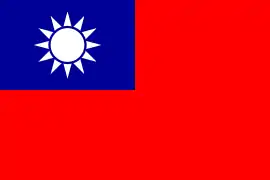 Taiwan, Republic of China (ROC)[246]
Taiwan, Republic of China (ROC)[246].svg.png.webp) Cebu, Philippines[246]
Cebu, Philippines[246] Isabela, Philippines[246]
Isabela, Philippines[246] Pangasinan, Philippines[246]
Pangasinan, Philippines[246] Ilocos Sur, Philippines[246]
Ilocos Sur, Philippines[246] Ilocos Norte, Philippines[246]
Ilocos Norte, Philippines[246]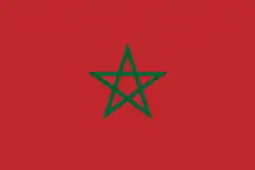 Rabat-Salé-Zemmour-Zaër, Morocco[246]
Rabat-Salé-Zemmour-Zaër, Morocco[246] Azores Islands, Portugal[246]
Azores Islands, Portugal[246] Bali, Indonesia[246]
Bali, Indonesia[246]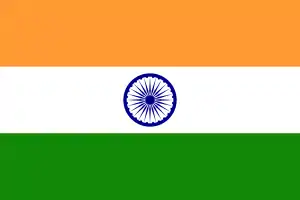 Goa, India[246]
Goa, India[246]
References
Informational notes
- Local usage generally reserves Hawaiian as an ethnonym referring to Native Hawaiians. Hawaii resident is the preferred local form to refer to state residents in general regardless of ethnicity. Hawaii may also be used adjectivally. The Associated Press Stylebook, 42nd ed. (2007), also prescribes this usage (p. 112).
- After Alaska, Florida, and California.
- Pollex—a reconstruction of the Proto-Polynesian lexicon, Biggs and Clark, 1994.[21] The asterisk preceding the word signifies that it is a reconstructed word form.
- The ʻokina, which resembles an apostrophe and precedes the final i in Hawaiʻi, is a consonant in Hawaiian and phonetically represents the glottal stop /ʔ/.
- For comparison, New Jersey—which has 8,717,925 people in 7,417 square miles (19,210 km2)—is the most-densely populated state in the Union with 1,134 people per square mile.
- English "to be" is often omitted in Pidgin. In contexts where "to be" is used in General American, "to stay" is preferred. "To stay" may have arisen due to an English calque of the Portuguese ser, estar, or ficar. Eh? (IPA: [æ̃ː˧˦]) is a tag question which may have roots in Japanese, which utilizes ね (ne?) to emphasize a point that may be agreed upon by all parties, or may come from Portuguese né? (shortened from "não é?"), cf. French n'est-ce pas ?. Eh? may also have come from English yeah.
- Senator Inouye, who ranked first in seniority, died in December 2012. Senator Daniel Akaka, who ranked 21st of the Senate's one hundred members, retired in January 2013 after serving twenty-three years in the Senate.
Citations
- Brodie, Carolyn S; Goodrich, Debra; Montgomery, Paula Kay (1996). The Bookmark Book. Englewood, Colo.: Libraries Unlimited. ISBN 9781563083006. OCLC 34164045. Retrieved August 5, 2015.
- "Play Ball holds unforgettable 1st event in Hawaii". MLB.com. Archived from the original on November 19, 2019. Retrieved April 6, 2020.
- Hawaii State Legislature. "Haw. Rev. Stat. § 5–9 (State motto)". Archived from the original on October 15, 2015. Retrieved December 9, 2013.
- Hawaii State Legislature. "Haw. Rev. Stat. § 5–10 (State song)". Archived from the original on January 16, 2003. Retrieved December 9, 2013.
- "Summit USGS 1977". NGS data sheet. U.S. National Geodetic Survey. Retrieved October 20, 2011.
- "Elevations and Distances in the United States". United States Geological Survey. 2001. Archived from the original on October 15, 2011. Retrieved October 21, 2011.
- Elevation adjusted to North American Vertical Datum of 1988.
- The summit of Mauna Kea is the highest point in Oceania. Mauna Kea is also the tallest mountain on Earth when measured from base to summit. The shield volcano sits on the floor of the Pacific Ocean at a depth of 5,998 meters (19,678 ft) for a total height of 10,205.3 meters (33,482 ft)
- "Median Annual Household Income". The Henry J. Kaiser Family Foundation. Archived from the original on December 20, 2016. Retrieved December 9, 2016.
- "Style Manual; An official guide to the form and style of Federal Government publishing" (PDF). United States Government Publishing Office. 2016. Archived (PDF) from the original on July 29, 2018. Retrieved April 27, 2020.
- Andrews, Evan. "6 Short-Lived Republics in the United States". HISTORY. Retrieved December 19, 2020.
- "Sovereign States of America: 10 States That Started as Free Countries & How They Joined the Union". Ammo.com. April 30, 1900. Retrieved January 17, 2021.
- "Is Hawaii a Part of Oceania or North America?". WorldAtlas. Archived from the original on July 11, 2019. Retrieved June 24, 2019.
- "[USC02] 48 USC Ch. 3: Front Matter". uscode.house.gov. Archived from the original on October 29, 2018. Retrieved October 28, 2019.
- "Religious Landscape Study". Pewforum.org. 11 May 2015. Retrieved 27 May 2018
- "Hawaii is home to the nation's largest share of multiracial Americans". Pew Research Center. Retrieved December 14, 2020.
- "Top 5 richest states in the US". www.worldfinance.com. Retrieved December 15, 2020.
- Locke, Taylor (September 5, 2019). "This is the most liveable city in America". CNBC. Retrieved December 15, 2020.
- Bruce Cartwright (1929). "The Legend of Hawaii-loa" (PDF). Journal of the Polynesian Society. 38: 105–121. Archived from the original (PDF) on July 13, 2007 – via Ethnomathematics Digital Library (EDL).
- "Origins of Hawaii's Names". Archived from the original on December 30, 2006. Retrieved February 24, 2007.
- Biggs, Bruce (1994). "Does Māori have a closest relative?". In Sutton, Douglas G. (ed.). The Origins of the First New Zealanders. Auckland, NZ: Auckland University Press. pp. 96–105. ISBN 978-1-86940-098-9.
Clark, Ross (1994). "Moriori and Māori: The Linguistic Evidence". In Sutton, Douglas G. (ed.). The Origins of the First New Zealanders. Auckland, NZ: Auckland University Press. pp. 123–135. ISBN 978-1-86940-098-9. - Pukui, M.K.; Elbert, S.H. (1986). Hawaiian Dictionary. Honolulu: University of Hawaii Press. p. 62. ISBN 978-0-8248-0703-0.
- Pukui, M.K.; Elbert, S.H.; Mookini, E.T. (1974). Place Names of Hawaii. Honolulu: University of Hawaii Press. ISBN 978-0-8248-0208-0.
- "Article XV, Section 4". The Constitution of the State of Hawaii. Hawaii Legislative Reference Bureau. Archived from the original on November 1, 2017. Retrieved March 18, 2015.
- "Article XV, Section 1". The Constitution of the State of Hawaii. Hawaii Legislative Reference Bureau. Archived from the original on November 1, 2017. Retrieved March 18, 2015.
- "The Constitution of the State of Hawaii". Hawaii Legislative Reference Bureau. Archived from the original on March 9, 2015. Retrieved March 18, 2015.
- "Hawaiian language". Wow Polynesia. December 2, 2009. Archived from the original on June 18, 2011. Retrieved April 16, 2011.
- Blay, Chuck, and Siemers, Robert. Kauai‘’s Geologic History: A Simplified Guide. Kaua‘i: TEOK Investigations, 2004. ISBN 9780974472300. (Cited in "Hawaiian Encyclopedia : The Islands". Retrieved June 20, 2012.)
- U.S. Geological Survey Geographic Names Information System: Island of Hawaiʻi
- U.S. Geological Survey Geographic Names Information System: Maui Island
- U.S. Geological Survey Geographic Names Information System: Oʻahu Island
- U.S. Geological Survey Geographic Names Information System: Kauaʻi Island
- U.S. Geological Survey Geographic Names Information System: Molokaʻi Island
- U.S. Geological Survey Geographic Names Information System: Lānaʻi Island
- U.S. Geological Survey Geographic Names Information System: Niʻihau Island
- U.S. Geological Survey Geographic Names Information System: Kahoʻolawe Island
- "What constitutes the United States, what are the official definitions?". United States Geological Survey. Archived from the original on November 16, 2017. Retrieved July 3, 2007.
- Rubin, Ken. "General Information about Hawaiian Shield Volcanoes". Archived from the original on December 29, 2010. Retrieved December 1, 2009.
- "Mauna Kea Volcano, Hawaii". Hvo.wr.usgs.gov. Archived from the original on October 21, 2006. Retrieved November 5, 2011.
- Unke, Beata (2001). "Height of the Tallest Mountain on Earth". The Physics Factbook. Archived from the original on August 19, 2007. Retrieved August 3, 2007.
- "Youngest lava flows on East Maui probably older than A.D. 1790". United States Geological Survey. September 9, 1999. Archived from the original on February 22, 2001. Retrieved May 5, 2015.
- "Living on Active Volcanoes—The Island of Hawaii, U.S. Geological Survey Fact Sheet 074-97". U.S. Geological Survey. Archived from the original on October 25, 2011. Retrieved November 5, 2011.
- Swanson, D. A.; Rausch, J (2008). "Human Footprints in Relation to the 1790 Eruption of Kīlauea". American Geophysical Union, Fall Meeting. 11: V11B–2022. Bibcode:2008AGUFM.V11B2022S.
- "Largest islands of the world". Worldatlas.com. Archived from the original on March 21, 2011. Retrieved April 16, 2011.
- Pacific Tsunami Warning Center (November 12, 2009). "Tsunami Safety & Preparedness in Hawaii". Archived from the original on March 7, 2011. Retrieved November 12, 2009.
- Le Bas, T.P. (2007). "Slope Failures on the Flanks of Southern Cape Verde Islands". In Lykousis, Vasilios (ed.). Submarine mass movements and their consequences: 3rd international symposium. Springer Science+Business Media. ISBN 978-1-4020-6511-8.
- Mitchell, N. (2003). "Susceptibility of mid-ocean ridge volcanic islands and seamounts to large scale landsliding". Journal of Geophysical Research. 108 (B8): 1–23. Bibcode:2003JGRB..108.2397M. doi:10.1029/2002jb001997. S2CID 131282494. Archived from the original on September 21, 2020. Retrieved December 16, 2019.
- "Man Whose Leg Was Shattered By Hawaii's Volcano Eruption Speaks Out". May 24, 2018. Archived from the original on June 1, 2018. Retrieved May 31, 2018.
- Howard Youth. "Hawaii's Forest Birds Sing the Blues". Archived from the original on March 18, 2007. Retrieved October 31, 2008.
- "Hawaiian Native Plant Propagation Database". Archived from the original on November 28, 2014. Retrieved December 15, 2013.
- Stephen Buchmann; Gary Paul Nabhan (June 22, 2012). The Forgotten Pollinators. ISBN 9781597269087. Retrieved December 17, 2013.
- "Hawaii". National Park Service. Archived from the original on July 3, 2008. Retrieved July 15, 2008.
- Joshua Reichert and Theodore Roosevelt IV (June 15, 2006). "Treasure Islands". Archived from the original on September 30, 2006.
- "Hawaiian Islands : Image of the Day". Earthobservatory.nasa.gov. June 3, 2003. Archived from the original on September 13, 2010. Retrieved November 5, 2010.
- "Climate of Hawaii". Prh.noaa.gov. Archived from the original on November 1, 2011. Retrieved November 5, 2011.
- "State Climate Extremes Committee (SCEC)". US National Oceanographic and Atmospheric Administration (NOAA), National Centers for Environmental Information. Archived from the original on February 21, 2018. Retrieved February 2, 2017.
- "Hawaii State Government". Netstate.com. Archived from the original on October 19, 2011. Retrieved November 5, 2011.
- Kirch, Patrick Vinton (1989). The Evolution of the Polynesian Chiefdoms. Cambridge University Press. pp. 77–79. ISBN 978-0-521-27316-9.
- West, Barbara A. (2009). Encyclopedia of the Peoples of Asia and Oceania. Infobase Publishing. p. 270. ISBN 978-1438119137.
- "The Name Owyhee" (PDF). Idaho State Historical Society. August 1964. Archived from the original (PDF) on August 16, 2014. Retrieved January 1, 2015.
- Kane, Herb Kawainui (1996). "The Manila Galleons". In Bob Dye (ed.). Hawaii Chronicles: Island History from the Pages of Honolulu Magazine. I. Honolulu: University of Hawaii Press. pp. 25–32. ISBN 978-0-8248-1829-6.
- "Ruy López de Villalobos (descubridor de Hawai)". heroesdehispania.blogspot.se (in Spanish). Archived from the original on January 6, 2017. Retrieved January 5, 2017.
- By Oliver, Douglas L. (1989). The Pacific Islands. University of Hawaii Press. p. 45. ISBN 0-8248-1233-6
- Coulter, John Wesley (1964). "Great Britain in Hawaii: The Captain Cook Monument". The Geographical Journal. 130 (2): 256–261. doi:10.2307/1794586. JSTOR 1794586.
- "Hawaiʻi Nature Notes". Hawaii National Park. June 1959. Archived from the original on November 8, 2012. Retrieved August 8, 2013.
- Katharine Bjork, "The Link that Kept the Philippines Spanish: Mexican Merchant Interests and the Manila Trade, 1571-1815," Journal of World History 9, no. 1 (1998), 25-50.
- Stanley D. Porteus, Calabashes and Kings: An Introduction to Hawaii. Kessinger Publishing, 2005; p. 17
- Kuykendall. The Hawaiian Kingdom Volume I: Foundation and Transformation. p. 18.
Cook's plan was to get the king on board the Resolution and keep him there until the stolen boat was returned—a plan that had been effective under similar circumstances in the south Pacific.
- Hawaii at the Encyclopædia Britannica
- United States Congress Senate United States Senate Committee on Indian Affairs (1993–) U.S. G.P.O., 2000 (2000). To express the policy of the United States regarding the United States' relationship with Native Hawaiians, and for other purposes: report (to accompany S. 2899). Washington, D.C. p. 7. Archived from the original on September 3, 2015. Retrieved May 6, 2015.
- "Migration and Disease". Digital History. Archived from the original on February 7, 2007.
- Greene, Linda W. (1985). National Historical Park : KALAUPAPA (PDF). National Park Service. p. 11. Archived (PDF) from the original on April 12, 2019. Retrieved June 18, 2018.
- Fry, Kathie. "Kamehameha Dynasty". Hawaii for Visitors. Archived from the original on November 7, 2016. Retrieved November 7, 2016.
- MacDonald, Margaret Read (December 16, 2013). Traditional Storytelling Today: An International Sourcebook. Routledge. p. 165. ISBN 9781135917142.
- Diamond, Heather A. (2008). American Aloha: Cultural Tourism and the Negotiation of Tradition. University of Hawaii Press. p. 15. ISBN 9780824831714.
- "Ho'oilina Legacy Collection". hooilina.org. Archived from the original on December 12, 2019. Retrieved February 12, 2017.
- Goucher, Candice; Walton, Linda (March 12, 2013). World History: Journeys from Past to Present. Routledge. p. 572. ISBN 9781135088293.
- Schmitt, Robert C. "Religious Statistics of Hawaii, 1825–1972" (PDF) (Typographical error in "1950", meant to be "1850"). p. 43. Archived (PDF) from the original on May 25, 2017.
- University of Michigan School of Education (January 1, 1947). Studies in the History of American Education. UM Libraries. p. 5.
- Martin, Dr Kathleen J. (June 28, 2013). Indigenous Symbols and Practices in the Catholic Church: Visual Culture, Missionization and Appropriation. Ashgate Publishing, Ltd. p. 89. ISBN 9781409480655.
- "Ulukau: The Hawaiian kingdom, vol. 3, 1874–1893, The Kalakaua dynasty". www.ulukau.org. Archived from the original on January 20, 2015. Retrieved February 12, 2017.
- "Ulukau: The Hawaiian kingdom, vol. 3, 1874–1893, The Kalakaua dynasty". www.ulukau.org. Archived from the original on January 20, 2015. Retrieved February 12, 2017.
- Russ, William Adam (1992). The Hawaiian Revolution (1893–94). Associated University Presses. p. 350. ISBN 978-0-945636-43-4.
- "Public Law 103-150—November 23, 1993" (PDF). gpo.gov. Archived (PDF) from the original on April 7, 2018. Retrieved July 3, 2018.
- Kuykendall, R.S. (1967). The Hawaiian Kingdom, 1874–1893. Honolulu: University of Hawaii Press. p. 648.
- Kinzer, Stephen (2006). Overthrow: America's Century of Regime Change From Hawaii to Iraq. Times Books. ISBN 978-0-8050-7861-9.
- "Rush Limbaugh Sounds Off on Akaka Bill". Hawaii Reporter. August 18, 2005. Archived from the original on May 12, 2013. Retrieved February 13, 2013.
- Fein, Bruce (June 6, 2005). "Hawaii Divided Against Itself Cannot Stand" (PDF). Honolulu: Grassroot Institute of Hawaii. Archived from the original on February 5, 2007. Retrieved May 7, 2015.
- "1897 Hawaii Annexation Treaty". The Morgan Report. Archived from the original on August 25, 2010. Retrieved August 14, 2010.
- "Anti-annexation petitions—Page 1". Libweb.hawaii.edu. Archived from the original on March 17, 2012. Retrieved March 9, 2012.
- Dyke, Jon M. Van (January 1, 2008). Who Owns the Crown Lands of Hawai_i?. University of Hawaii Press. p. 209. ISBN 9780824832117.
- "Sacramento Daily Union 16 June 1898—California Digital Newspaper Collection". cdnc.ucr.edu. Archived from the original on February 13, 2017. Retrieved February 12, 2017.
- "Annexation Timeline—of the overthrow of the Kingdom of Hawaii". hrmakahinui.com. Archived from the original on November 17, 2016. Retrieved February 12, 2017.
- "Hawaii Statehood—Honolulu Star-Bulletin by HAWAII: Honolulu, Hawaii No binding—Seth Kaller Inc". www.abebooks.co.uk. Archived from the original on February 13, 2017. Retrieved February 12, 2017.
- Jennifer Ludden. "1965 immigration law changed face of America". NPR. Archived from the original on October 21, 2016. Retrieved September 3, 2016.
- "Red States Outnumber Blue for First Time in Gallup Tracking". gallup.com. February 3, 2016. Archived from the original on January 4, 2017. Retrieved January 5, 2017.
- [ 2016 election result—Politico]
- Boundless (August 8, 2016). "Red States vs. Blue States". Boundless.com. Archived from the original on November 12, 2016. Retrieved January 5, 2017.
- "2012 Presidential Race—Election Results by State—NBC News". nbcnews.com. December 2, 2011. Archived from the original on January 6, 2017. Retrieved January 5, 2017.
- Video: Aloha Hawaii. islanders Celebrate Long-Sought Statehood, 1959/03/16 (1959). Universal Newsreel. 1959. Archived from the original on May 15, 2012. Retrieved February 20, 2012.
- "Commemorating 50 Years of Statehood". archive.lingle.hawaii.gov. State of Hawaii. March 18, 2009. Archived from the original on March 21, 2014. Retrieved March 21, 2014.
On June 27, 1959, a plebiscite was held to allow Hawaiʻi residents to ratify the congressional vote for statehood. The 'yes for statehood' garnered 94.3 percent (132,773 votes) while the 'no' ballots totaled 5.7 percent (7,971 votes).
- Van Dyke, Jon (1985). "The Constitutionality of the Office of Hawaiian Affairs". University of Hawaii Law Review. 7: 63. Archived from the original on September 21, 2020. Retrieved June 18, 2018.
- mauimapp.com. Hawaiian Words; Hawaiian to English [archived September 14, 2008; Retrieved September 19, 2008].
- Hasan, Heather (2012), Wikipedia, 3.5 million articles and counting, p. 11, ISBN 9781448855575
- Andrews, Lorrin (1865), A dictionary of the Hawaiian language to which is appended an English-Hawaiian vocabulary and a chronological table of remarkable events, Henry M. Whitney, p. 514, archived from the original on August 15, 2014, retrieved April 27, 2019
- Schmitt, Robert C. (1968). Demographic Statistics of Hawaii, 1778–1965 (PDF). Honolulu: University of Hawaii Press. pp. 41, 69. hdl:10125/30985. OCLC 760489664.
- "U.S. Census website". United States Census Bureau. Archived from the original on December 27, 1996. Retrieved October 21, 2007.
- "Hawaiian Encyclopedia : Population and Visitor Statistics". Hawaiianencyclopedia.com. July 1, 2002. Archived from the original on December 14, 2013. Retrieved January 21, 2014.
- "QuickFacts Hawaii; UNITED STATES". 2018 Population Estimates. United States Census Bureau, Population Division. March 10, 2019. Archived from the original on December 30, 2018. Retrieved March 10, 2019.
- Lee, Fiona (December 29, 2020). "People leaving Hawaii doubled in 2020". SFGATE. Retrieved December 29, 2020.
- "Las Vegas: Bright Lights, Big City, Small Town". State of the Reunion. Archived from the original on June 2, 2013. Retrieved July 5, 2013.
- "Hawaii's ninth island offers everything we need". Honolulu Advertiser. Archived from the original on January 10, 2014. Retrieved July 6, 2013.
- "Hawaii Quickfacts". Quickfacts.census.gov. Archived from the original on October 28, 2011. Retrieved November 5, 2011.
- "Resident Population Data—2010 Census". 2010 Census. Washington, DC: U.S. Census Bureau. Archived from the original on October 28, 2011. Retrieved May 7, 2012.
- "Average life expectancy at birth by state". Archived from the original on June 15, 2010. Retrieved November 5, 2011.
- "Active Duty Military Personnel Strengths by Regional Area and by Country (309A)" (PDF). Department of Defense. September 30, 2013. Archived from the original (PDF) on October 19, 2012. Retrieved October 21, 2013.
- "Hawaii QuickFacts from the US Census Bureau". State and County QuickFacts. Washington, DC: U.S. Census Bureau. January 17, 2012. Archived from the original on October 28, 2011. Retrieved June 2, 2012.
- Population Division, Laura K. Yax. "Historical Census Statistics on Population Totals By Race, 1790 to 1990, and By Hispanic Origin, 1970 to 1990, For The United States, Regions, Divisions, and States". Archived from the original on July 25, 2008.
- "Population of Hawaii: Census 2010 and 2000 Interactive Map, Demographics, Statistics, Quick Facts". Archived from the original on January 7, 2014.
- Center for New Media and Promotions(C2PO). "2010 Census Data". Archived from the original on May 22, 2017. Retrieved December 9, 2017.
- U.S. Census Bureau. "American FactFinder—Results". census.gov. Archived from the original on February 14, 2020. Retrieved January 5, 2017.
- Exner, Rich (June 3, 2012). "Americans under age 1 now mostly minorities, but not in Ohio: Statistical Snapshot". The Plain Dealer. Archived from the original on July 14, 2016. Retrieved November 4, 2012.
- "Profile of General Population and Housing Characteristics: 2010 Demographic Profile Data". US Census Bureau. Archived from the original on May 21, 2019. Retrieved May 22, 2012.
- "Race Reporting for the Native Hawaiian and Other Pacific Islander Population by Selected Categories: 2010". US Census Bureau. Archived from the original on March 28, 2015. Retrieved April 29, 2013.
- "Hawaii—Race and Hispanic Origin: 1900 to 1990". U.S. Census Bureau. Archived from the original on July 25, 2008.
- "California's Hispanic population projected to outnumber white in 2014". Reuters. January 31, 2013. Archived from the original on October 17, 2015. Retrieved July 1, 2017.
- American FactFinder, United States Census Bureau. "Hawaii—ACS Demographic and Housing Estimates: 2008". Factfinder.census.gov. Archived from the original on February 11, 2020. Retrieved May 15, 2010.
- "Hawaii". Archived from the original on December 2, 2010.
- Williams, Charles (1832) [1828]. The missionary gazetteer: comprising a geographical and statistical account ... CIHM/ICMH microfiche series, no. 35042 (also ATLA monograph preservation program; ATLA fiche 1988–3226). B B Edwards (America ed.). Boston, MA: W. Hyde & Co. p. 424. ISBN 978-0-665-35042-9. OCLC 657191416, 718098082, 719990067, 680518873. Retrieved May 3, 2012.
- Goto, Junichi (April 2007). "Latin Americans of Japanese Origin (Nikkeijin) Working in Japan—A Survey" (PDF). Documents & Reports—All Documents | The World Bank. Washington, DC: World Bank. pp. 5, 48. Archived (PDF) from the original on June 11, 2012. Retrieved May 3, 2012.
- "+ Hawaii Alive | Realms: Wao Lani +". Hawaii Alive. Honolulu, HI: Bishop Museum. Archived from the original on April 26, 2012. Retrieved May 3, 2012.
- Hoffman, Frederic L. (September 1899). "The Portuguese Population in the United States". Publications of the American Statistical Association. 6 (47): 327–336. doi:10.2307/2276463. JSTOR 2276463. OCLC 11137237.(subscription required) See pp. 332–33.
- López, Iris (May 3, 2006). "Puerto Ricans in Hawaii". In Ruiz, Vicki L.; Korrol, Virginia Sánchez (eds.). Latinas in the United States: A Historical Encyclopedia. Gale Virtual Reference Library. 2. Bloomington, IN: Indiana University Press. pp. 591–95. ISBN 978-0-253-34680-3. OCLC 74671044, 748855661, 756540171. Retrieved May 3, 2012.
- "THE CONSTITUTION OF THE STATE OF HAWAII". Archived from the original on January 26, 2018. Retrieved February 4, 2018.
- "Language Map Data Center". Mla.org. July 17, 2007. Archived from the original on August 31, 2011. Retrieved November 5, 2011.
- Lyovin, Anatole V. (1997). An Introduction to the Languages of the World. New York: Oxford University Press, Inc. pp. 257–58. ISBN 978-0-19-508116-9.
- "Table 1. Detailed Languages Spoken at Home and Ability to Speak English for the Population 5 Years and Over for the United States: 2006–2008" (MS-Excel Spreadsheet). American Community Survey Data on Language Use. Washington, DC: U.S. Census Bureau. April 2010. Archived from the original on September 22, 2014. Retrieved May 7, 2012.
- Schütz, Albert J., 1937- (1994). The voices of Eden : a history of Hawaiian language studies. Honolulu, Hawaii: University of Hawaii Press. ISBN 0-585-28415-6. OCLC 45733324.CS1 maint: multiple names: authors list (link)
- Schütz, Albert J. (1994). The Voices of Eden: A History of Hawaiian Language Studies. Honolulu: University of Hawaii Press. pp. 334–36, 338 20n. ISBN 978-0-8248-1637-7.
- Elbert, Samuel H.; Pukui, Mary Kawena (1979). Hawaiian Grammar. Honolulu: The University Press of Hawaii. pp. 35–36. ISBN 0-8248-0494-5.
- Kimura, Larry; Pila, Wilson (1983). "Native Hawaiian Culture". Native Hawaiian Study Commission Minority Report. Washington: United States Department of Interior. pp. 173–203 [185].
- "Layouts: Hawaiian (haw)". unicode.org. Archived from the original on May 25, 2017. Retrieved January 5, 2017.
- "Adults in Hawaii". Religious Landscape Study. Pew Research Center. Archived from the original on July 7, 2019. Retrieved October 28, 2019.
- "The Association of Religion Data Archives | State Membership Report". www.thearda.com. Archived from the original on November 12, 2013. Retrieved November 12, 2013.
- "Facts and Statistics" Archived May 23, 2020, at the Wayback Machine, Church News, 2020. Retrieved on March 30, 2020.
- "The Association of Religion Data Archives—Maps & Reports". Archived from the original on April 21, 2014. Retrieved April 20, 2014.
- "State of Hawaii Data Book 2000, Section 1 Population, Table 1.47". Hawaii.gov. Archived from the original on October 20, 2011. Retrieved November 5, 2011.
- "Survey shows partial picture". The Honolulu Advertiser. September 21, 2002. Archived from the original on October 9, 2011. Retrieved November 5, 2011.
- Bernard Katz. "The Jewish Community of Maui, Hawaii". Museum of the Jewish People – Beit Hatfutsot. Archived from the original on January 1, 2018. Retrieved March 14, 2020.
- "National Vital Statistics Reports Births: Final Data for 2013" (PDF). U.S. Department of Health and Human Services. January 15, 2015. Archived (PDF) from the original on September 11, 2017. Retrieved April 18, 2018.
- "National Vital Statistics Reports Births: Final Data for 2014" (PDF). U.S. Department of Health and Human Services. December 23, 2015. Archived (PDF) from the original on February 14, 2017. Retrieved April 18, 2018.
- "National Vital Statistics Reports Births: Final Data for 2015" (PDF). U.S. Department of Health and Human Services. January 5, 2017. Archived (PDF) from the original on August 31, 2017. Retrieved April 18, 2018.
- "Births: Final Data for 2016" (PDF). www.cdc.gov. NVSS. Archived (PDF) from the original on June 3, 2018. Retrieved May 4, 2018.
- "Births: Final Data for 2017" (PDF). www.cdc.gov. NVSS. Archived (PDF) from the original on February 1, 2019. Retrieved February 18, 2019.
- "Data" (PDF). www.cdc.gov. Archived (PDF) from the original on November 28, 2019. Retrieved December 2, 2019.
- Stephen O. Murray (June 1, 2002). Homosexualities. University of Chicago Press. pp. 99–. ISBN 978-0-226-55195-1. Archived from the original on June 27, 2014. Retrieved May 22, 2019.
- William Kornblum (January 31, 2011). Sociology in a Changing World. Cengage Learning. p. 165. ISBN 978-1-111-30157-6. Archived from the original on June 27, 2014. Retrieved May 22, 2019.
- Michael Klarman (October 18, 2012). From the Closet to the Altar: Courts, Backlash, and the Struggle for Same-Sex Marriage. Oxford University Press. pp. 56–. ISBN 978-0-19-992210-9. Archived from the original on June 27, 2014. Retrieved May 22, 2019.
- Carol R. Ember; Melvin Ember (December 31, 2003). Encyclopedia of Sex and Gender: Men and Women in the World's Cultures Topics and Cultures A–K—Volume 1; Cultures L–Z. Springer. pp. 207–. ISBN 978-0-306-47770-6. Archived from the original on May 15, 2016. Retrieved May 22, 2019.
- Bonnie Zimmerman (2000). Lesbian Histories and Cultures: An Encyclopedia. Taylor & Francis. pp. 358–. ISBN 978-0-8153-1920-7. Archived from the original on December 23, 2016. Retrieved May 22, 2019.
- Xian, Kathryn and Brent Anbe (Directors) (2001). Ke Kūlana He Māhū: Remembering a Sense of Place (DVD).
- Noenoe K. Silva (2004). Aloha Betrayed: Native Hawaiian Resistance to American Colonialism. Duke University Press Durham & London. pp. 66, 77. ISBN 0-8223-8622-4. Archived from the original on September 21, 2020. Retrieved June 7, 2019.
- Gates, Gary J.; Newport, Frank (February 15, 2013). "LGBT Percentage Highest in D.C., Lowest in North Dakota". Gallup, Inc. Archived from the original on May 16, 2014. Retrieved May 9, 2015.
- Gates, Gary J.; Newport, Frank (April 24, 2015). "An Estimated 780,000 Americans in Same-Sex Marriages". Gallup, Inc. Archived from the original on April 29, 2015. Retrieved May 9, 2015.
- "Hawaii Senate passes gay marriage bill". USA Today. November 13, 2013. Archived from the original on July 10, 2017. Retrieved August 22, 2017.
- "Hawaii sandalwood trade". Hawaiihistory.org. Archived from the original on October 5, 2011. Retrieved November 5, 2011.
- "Whaling in Hawaii". Hawaiihistory.org. June 16, 1999. Archived from the original on October 5, 2011. Retrieved November 5, 2011.
- "Per capita GDF by year". State of Hawaii. Archived from the original on September 11, 2016. Retrieved August 25, 2016.
- "A History of Honey Bees in the Hawaiian Islands". Archived from the original on September 8, 2010. Retrieved December 15, 2011.
- "Hawaii honeybees vie for most valuable export". Archived from the original on September 21, 2020. Retrieved December 15, 2011.
- "Hawaii is genetically engineered crop flash point". KLEW_TV. Associated Press. April 19, 2014. Archived from the original on November 12, 2019. Retrieved April 18, 2018.
- Pollack, Andrew (October 7, 2013). "Unease in Hawaii's Cornfields". The New York Times. Archived from the original on August 31, 2014. Retrieved October 18, 2014.
- "Local Area Unemployment Statistics". www.bls.gov. US Bureau of Labor Statistics. Archived from the original on July 25, 2018. Retrieved February 25, 2016.
- "Study: Military spent $12B in Hawaii in 2009". Military Times. Associated Press. June 1, 2011. Archived from the original on September 21, 2020. Retrieved June 1, 2011.
- Frank, Robert. "Top states for millionaires per capita". CNBC. Archived from the original on January 22, 2014. Retrieved January 22, 2014.
- "Department of Taxation". tax.hawaii.gov. Archived from the original on December 31, 2019. Retrieved January 3, 2020.
- "Honolulu Star-Bulletin Hawaii News". Starbulletin.com. November 30, 2006. Archived from the original on September 19, 2008. Retrieved November 5, 2011.
- "Cost of Living Wizard". The New York Times. Archived from the original on September 14, 2008.
- "Amazon.com Help: About Shipping to Alaska, Hawaii, & Puerto Rico Addresses". www.amazon.com. Archived from the original on December 14, 2018. Retrieved June 18, 2018.
- "(No) free shipping to Hawaii—Living in Hawaii—Moving to Oahu, Maui, Kauai, Big Island". www.aimforawesome.com. Archived from the original on June 18, 2018. Retrieved June 18, 2018.
- Chesto, Jon (January 29, 2015). "House bill aims to address state's power shortfall". The Boston Globe (February 8, 2015). Archived from the original on June 29, 2017. Retrieved June 21, 2017.
- "Historic Housing Values". www.census.gov. Archived from the original on October 29, 2017. Retrieved December 9, 2017.
- "Metropolitan Median Prices". Realtor.org. February 15, 2005. Archived from the original on November 3, 2011. Retrieved November 5, 2011.
- "Keeping up with the Jones Act". Hawaii Business Magazine. Honolulu, HI: PacificBasin Communications. August 2012. Archived from the original on August 23, 2012. Retrieved March 14, 2014.
- Hansen, Michael (October 3, 2013). "Jones Act Does Not Bar International Trade From Hawaii". Honolulu, Hawaiʻi: Hawaiʻi Free Press. Archived from the original on July 28, 2018. Retrieved July 28, 2018.
- Lynch, Russ (April 4, 1997). "U.S.-only shipping rule praised, blasted; Backers and foes of the Jones Act make their case before the Legislature". Honolulu Star-Bulletin. Honolulu, HI: Black Press Group Ltd. ISSN 0439-5271. OCLC 9188300, 433678262, 232117605, 2268098. Archived from the original on October 13, 2012. Retrieved May 5, 2012.
- Kirch, Patrick Vinton; Roger Green (2001). Hawaiki, Ancestral Polynesia: An Essay in Historical Anthropology. Cambridge University Press. pp. 99–119. ISBN 978-0-521-78309-5.
- Wilmshurst, Janet (December 27, 2010). "High-precision radiocarbon dating shows recent and rapid initial human colonization of East Polynesia". Proceedings of the National Academy of Sciences of the United States of America. US National Library of Medicine. 108 (5): 1815–1820. doi:10.1073/pnas.1015876108. PMC 3033267. PMID 21187404.
- Unterberger, Richie (1999). Music USA. London: Rough Guides. pp. 465–473. ISBN 978-1-85828-421-7.
- Manuel, Peter (1988). Popular Musics of the Non-Western World. New York: Oxford University Press. pp. 236–241. ISBN 978-0-19-506334-9.
- Kamakawiwo, Israel (December 6, 2010). "Israel Kamakawiwo'ole: The Voice Of Hawaii". NPR. Archived from the original on April 16, 2017. Retrieved April 16, 2017.
- Hawaii State DBEDT (2003). "Overview of All Visitors" (PDF). Summary of 2003 Visitors to Hawaii: 2. Archived (PDF) from the original on December 9, 2010. Retrieved February 23, 2012.
- Hawaii.gov. "Tourism stats" (PDF). Archived (PDF) from the original on January 1, 2016.
- "Merrie Monarch Festival 2005". The Honolulu Advertiser. Archived from the original on October 5, 2009. Retrieved May 15, 2010.
- Nelson, Shane (August 8, 2011). "Hawaii International Film Festival: Kinship through cinema". Travel Weekly. OCLC 60626324. Archived from the original on November 14, 2012. Retrieved May 10, 2012.
- "19th Annual Honolulu Rainbow Film Festival at Doris Duke Theatre: Honolulu Hawaii Nightlife Event Guide". Hnlnow.com. Archived from the original on August 27, 2009. Retrieved May 15, 2010.
- "Honolulu Star-Bulletin Features". Archives.starbulletin.com. May 29, 2001. Archived from the original on July 5, 2010. Retrieved November 5, 2011.
- "Two-Thirds of Hawaii Schools Do Not Meet Requirements—Education News Story—KITV Honolulu". Thehawaiichannel.com. August 18, 2005. Archived from the original on March 18, 2007. Retrieved May 15, 2010.
- Honolulu Advertiser, August 17, 2005, p. B1
- US: Hawaii Investment and Business Guide Volume 1. Intl Business Pubns USA. March 20, 2009. p. 34. ISBN 978-1438721880. Archived from the original on September 21, 2020. Retrieved October 30, 2019.
- "News—Official 2011–12 Public and Charter School Enrollment". Hawaii Public Schools. Honolulu, HI: Hawaiʻi Department of Education. October 12, 2011. Archived from the original on March 9, 2012. Retrieved May 12, 2012.
- Jordan, Cynthia (October 10, 2011). "Private School Enrollment Report 2011–2012" (PDF). Hawaii Association of Independent Schools. Honolulu, HI: Hawaii Association of Independent Schools. p. 3. Archived (PDF) from the original on January 17, 2013. Retrieved May 12, 2012.
- Hussar, William J.; Bailey, Tabitha M. (September 11, 2009). "Projections of Education Statistics to 2018" (PDF). National Center for Education Statistics (NCES) Home Page, a part of the U.S. Department of Education. Washington, DC: National Center for Education Statistics. p. 6 (22 out of 68). Archived from the original (PDF) on September 19, 2009. Retrieved May 12, 2012.
- Wong, Alia (March 17, 2014). "Living Hawaii: Many Families Sacrifice to Put Kids in Private Schools". Honolulu Civil Beat. Retrieved October 7, 2020.
- "Kamehameha Schools 2013–2014 Annual Report" (PDF). Archived (PDF) from the original on June 3, 2015. Retrieved September 28, 2015.
- Ishibasha, Koren (November 2005). "Official Enrollment" (PDF). Archived from the original (PDF) on May 27, 2010. Retrieved December 1, 2009.
- "Department of Transportation—Hawaii's biggest airport officially renamed Daniel K. Inouye International Airport". hidot.hawaii.gov. Archived from the original on July 6, 2017. Retrieved July 5, 2017.
- Horvat, William J. "Inter-Island Airways/Hawaiian Airlines—Hawaii Aviation". Hawaii's Aviation History. Honolulu, HI: State of Hawaii. Archived from the original on March 14, 2012. Retrieved May 5, 2012.
- Cataluna, Lee (December 23, 2005). "Nothing Smooth on Seaflite". The Honolulu Advertiser. Archived from the original on October 9, 2011. Retrieved August 12, 2011.
- "Aloha, Superferry Alakai leaves Hawaii to find job". Honolulu Star-Bulletin. Honolulu, HI: Black Press Group Ltd. March 29, 2009. ISSN 0439-5271. OCLC 9188300, 433678262, 232117605, 2268098. Archived from the original on October 13, 2012. Retrieved May 8, 2012.
- "Expeditions: Maui—Lanaʻi Ferry Service". Archived from the original on May 9, 2012. Retrieved May 5, 2012.
- "Molokai ferry ends service this month | News, Sports, Jobs—Maui News". Archived from the original on October 28, 2019. Retrieved October 28, 2019.
- "Hawaii Cruises Cruise Overview | Hawaii Cruises Cruise Destinations & Vacation Packages". Norwegian Cruise Line. Miami-Dade County, FL: Norwegian Cruise Line. Archived from the original on May 3, 2012. Retrieved May 5, 2012.
- "Hawaii, Tahiti, & South Pacific Cruises". Princess Cruises. Santa Clarita, CA: Princess Cruises. Archived from the original on May 5, 2012. Retrieved May 5, 2012.
- Norton Jr., Victor; Treiber, Gale E. (2005). Hawaiian Railway Album—WW II Photographs Vol 2. Hanover, PA: Railroad Press.
- "Number of Local Governments by Type" (PDF). U.S. Census Bureau. Archived (PDF) from the original on December 8, 2015. Retrieved December 4, 2015.
- "Hawaii" (PDF). U.S. Census Bureau. Archived (PDF) from the original on March 4, 2016. Retrieved December 4, 2015.
- "Hawaii's 4 (or 5) Counties". Archived from the original on August 5, 2007. Retrieved January 22, 2014.
- "Representative Kai Kahele". kahele.house.gov. Retrieved January 14, 2021.
- Blackwell, Sarah (January 4, 2013). "msnbc's The Daily Rundown, 23 December 2009, accessed 6 January 2012". nbcnews.com. Archived from the original on January 9, 2013. Retrieved January 6, 2013.
- "2016 State PVI Changes". Decision Desk HQ. Archived from the original on June 13, 2018.
- Kaste, Martin (September 13, 2012). "Can A Republican Win A Senate Seat in Blue Hawaii?". NPR. Archived from the original on May 26, 2015. Retrieved May 17, 2015.
- Bernstein, Adam (August 19, 2004). "Hiram Fong Dies; One of First Hawaiian Senators". Washington Post. Archived from the original on September 3, 2015. Retrieved May 17, 2015.
- Rudin, Ken (December 23, 2009). "NPR's Political Junkie". Npr.org. Archived from the original on May 11, 2011. Retrieved May 15, 2010.
- "Asian Writer Ponders First Asian President Too". Npr.org. October 29, 2008. Archived from the original on February 17, 2011. Retrieved May 15, 2010.
- R Spencer Kidd (November 23, 2012). UNIFORMS OF THE U.S. STATE POLICE & HIGHWAY PATROLS. Lulu.com. pp. 33–. ISBN 978-1-4717-7729-5. Archived from the original on September 21, 2020. Retrieved April 30, 2020.
- "Hawaiian Kingdom—David Keanu Sai v. Barack Obama, et al". hawaiiankingdom.org. Archived from the original on October 28, 2019. Retrieved October 28, 2019.
- "Hawaiʻi and the United Nations". Cultural Survival. Archived from the original on October 8, 2015. Retrieved October 20, 2015.
- Umi Perkins. "Maori and Native Hawaiian Education". Archived from the original on September 21, 2020. Retrieved December 3, 2017.
- "Kamakakuokalani Center for Hawaiian Studies". University of Hawaii at Manoa. Archived from the original on December 1, 2017. Retrieved November 24, 2017.
- "Hawaiians Weigh Options as Native-Status Bill Stalls". The New York Times. June 11, 2006. Archived from the original on July 3, 2018. Retrieved July 3, 2018.
- "Ka Lahui Hawaiʻi: Akaka Bill Has Plenty of Vocal Opposition". March 8, 2005. Archived from the original on September 21, 2020. Retrieved July 3, 2018.
- Imani Altemus-Williams (December 7, 2015). "Towards Hawaiian Independence: Native Americans warn Native Hawaiians of the dangers of Federal Recognition". IC. Center for World Indigenous Studies. Archived from the original on July 3, 2018. Retrieved July 3, 2018.
- ʻUmi Perkins (January 16, 2015). "Is Hawaiʻi an Occupied State?". The Nation. Archived from the original on July 8, 2018. Retrieved July 7, 2018.
- Johnny Liberty; Richard Neff Hubbard (March–April 1996). "The Rape of Paradise: The Second Century Hawaiʻians Grope Toward Sovereignty As The U.S. President Apologizes". Perceptions Magazine. pp. 18–25. Archived from the original on March 3, 2016. Retrieved October 30, 2015 – via HAWAI`I Independent & Sovereign.
- Grass, Michael (August 12, 2014). "As Feds Hold Hearings, Native Hawaiians Press Sovereignty Claims". Government Executive. Government Executive. Archived from the original on October 7, 2015. Retrieved October 29, 2015.
- United States Social Forum. Book Committee (2010). The United States Social Forum: Perspectives of a Movement. Lulu.com. p. 294. ISBN 978-0-557-32373-9.
- Aran Alton Ardaiz (2008). Hawaii—The Fake State. Trafford Publishing. p. 153. ISBN 978-1-4251-7524-5.
- United States Social Forum. Book Committee (2010). The United States Social Forum: Perspectives of a Movement. Lulu.com. p. 294. ISBN 978-0-557-32373-9.
- Aran Alton Ardaiz (2008). Hawaii—The Fake State. Trafford Publishing. p. 153. ISBN 978-1-4251-7524-5.
- "International exchange activated with globalization". Ehime Prefecture. Archived from the original on September 30, 2018. Retrieved October 27, 2018.
- "ハワイアンフェスティバル in 福岡 2018" (in Japanese). Fukuoka Prefecture. Archived from the original on April 14, 2019.
- "広島県・ハワイ州友好提携20周年記念(展示会) 広島から世界へ―移住の歴史と日系人の暮らし― を開催しました。" (in Japanese). Hiroshima Prefecture. Archived from the original on April 14, 2019.
- "Hokkaido Sister City and Affiliated Regions Round Table Meeting". Hokkaido. Archived from the original on March 5, 2019. Retrieved March 5, 2019.
- "沖縄・ハワイ州姉妹提携30周年記念式典(10月9日)" (in Japanese). Okinawa Prefecture. Archived from the original on April 14, 2019.
- "Hawaii's Sister-States". State of Hawai'i. Archived from the original on October 16, 2020.
Bibliography
- Bushnell, Oswald A. (1993). The Gifts of Civilization: Germs and Genocide in Hawai?i. University of Hawaii Press. ISBN 978-0-8248-1457-1.
- Holmes, T. Michael (1994). The Specter of Communism in Hawaii. University of Hawaii Press. ISBN 978-0-8248-1550-9.
- Russ Jr., William Adam (1961) The Hawaiian Republic (1894–98) and Its Struggle to Win Annexation. Selinsgrove, Pennsylvania: Susquehanna University Press.
- Schamel, Wynell; Schamel, Charles E. (August 15, 2016). "The 1897 Petition Against the Annexation of Hawaii". National Archives. Retrieved October 10, 2017.
- Schamel, Wynell and Charles E. Schamel. "The 1897 Petition Against the Annexation of Hawaiʻi." Social Education 63, 7 (November/December 1999): 402–08.
- Stokes, John F. G. (October 12, 1932). "Spaniards and the Sweet Potato in Hawaii and Hawaiian-American Contacts". American Anthropologist. 34 (4): 594–600. doi:10.1525/aa.1932.34.4.02a00050. ISSN 1548-1433.
External links
- Official website
- Hawaii State Guide from the Library of Congress
- Hawaii at Curlie
- Hawaiʻi State Fact Sheet from the U.S. Department of Agriculture
- USGS real-time, geographic, and other scientific resources of Hawaii
- Energy Data & Statistics for Hawaii
- Satellite image of Hawaiian Islands at NASA's Earth Observatory
- Documents relating to Hawaii Statehood, Dwight D. Eisenhower Presidential Library
- Happily a State, Forever an Island by The New York Times
- "Hawaiʻi Then and Now"—slideshow by Life magazine (Archived from the original on November 3, 2010)
 Geographic data related to Hawaii at OpenStreetMap
Geographic data related to Hawaii at OpenStreetMap- Hawaiian Imprint Collection From the Rare Book and Special Collections Division at the Library of Congress
| Preceded by Alaska |
List of U.S. states by date of statehood Admitted on August 21, 1959 (50th) |
Most recent |
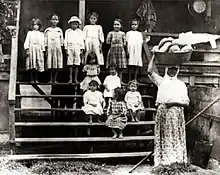
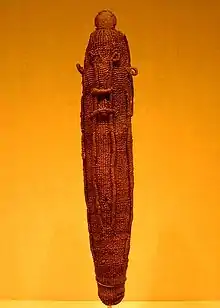
.svg.png.webp)